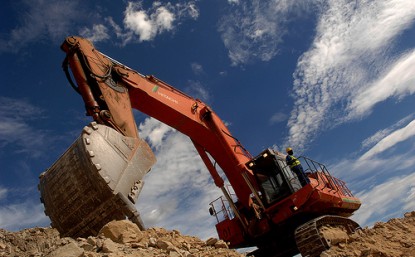
The following interview of Galane Gold’s CEO Nick Brodie took place by phone and email on February 24-25. The opinions expressed are entirely those of Mr. Brodie. I own shares of Galane Gold. Please see applicable discloses at the bottom of this article.
Can you provide readers with an overview of Galane Gold’s operations and prospects?
Galane Gold owns the Mupane Gold Mine which is situated in Botswana. Mupane has produced over 650,000 ozs of gold since mining commenced there in 2005 and it is our view that it has a long future in front of it. Ore is currently sourced from open pits, underground mines and historical low grade stockpiles and is processed through a mill and conventional CIL plant. It has matured into a mine with a forecast all in operating cost of $1,050 per ounce and a rolling 5 year plan.
Every mining company boasts that they have a superb management and/or Board. Can you describe your team?
Galane inherited a mine which had lacked continuity in senior management. We saw it as a critical part of the turn-around of the mine that we built a strong team with specific experience in mining and processing in the Greenstone belt. The first step was to find a new General Manager and we quickly identified Wayne Hatton-Jones as the most suitable fit. He is a mining professional with over 26 years’ experience in Africa, Asia and Europe. Having worked previously at Goldridge, Galaxy Gold, Avocet, Randgold and Harmony with the majority of his experience being in the greenstone belt in South Africa. His background and qualifications are Metallurgical which was critical for us to manage the fact we were transitioning from a predominately oxide ore to a sulphide ore. In addition he had experience in managing the move from an open pit to underground operation. An example of what Wayne has brought is that before Wayne had arrived we were advised that the cost of moving to an underground operation at Tau would cost over $10m with his experienced we actually installed a force portal and the total cost was $500k.
As always in mining Wayne then gave us access to numerous strong individuals that he has worked with historically. In particular we recruited Geoff McLoughlin a metallurgist with 29 years’ experience in operation and plant design. He is currently in charge of implementing the gravity plant circuit which we has designed and will build in house. He also managed the screening plant construction which we acquired second hand for $30k and rebuilt at site and has given us access to over 2mt of previously considered low grade stockpile at a direct operating cost of $600 to $700 per ounce. Another new member of the team is Kevin Crossling who we recruited as the Business Development Manager and he is a geologist with over 16 years of experience especially in the Greenstone environment. His responsibility is identifying new opportunities at our brownfield mine sites as well as oversight of our mining operations. Finally and not to be forgotten we have managed to retain Charles Byron as our exploration geologist. He has been associated with the Greenstone belt in Botswana since 1995 and his experience is invaluable both as a repository of historic information but also as the individual who will assist us in our approach to replace resources and we deplete them.
On the board side I would say our strongest asset is Ravi Sood who has extensive experience and profile in the Canadian market. He is an active Chairman who takes a strong interest in the marketing of the Company and the long term strategy. He has raised over $1bn in capital for various projects and is always looking to see how he can assist with the operation.
February is almost over, are you able to reiterate 2015 production guidance of about 45k ounces of gold at all-in costs of roughly $1,050/oz?
Our latest presentation on our new website, which I recommend you visit, shows guidance of around 45k ozs and a rough all in cost of $1,050 per ounce. It should be noted that in 2015 the first 6 months of the year sees us spending over $6m on capital projects and in particular the completion of development underground and the instillation of the gravity circuit. Therefore production will be low and costs higher than this but it will be corrected in the second half when we start stoping underground and process the Tekwane ore.
The $1,050 all in sustaining cost is based on our current 5 year plan. When running the plan we base it on the current gold price of $1,200 per ounce and we have the advantage that we have various sources of ore. We therefore can base production, pit sizes, cut off grades etc… on what we believe provides the optimum return to shareholders at a particular gold price. We have the ability to reduce the cost, but at lower production levels, if the gold price decreases. For example, we could just process the low grade stockpiles for 2 years at a direct operating cost of between $600-$700 per ounce (current plan $850-$950). We can also increase production as we have excess capacity in the plan at the plant but have decided not to mine certain resources as they are marginal. With a higher gold price this decision would be reviewed. Most small producers are dependent on one source of ore and do not have this flexibility. Therefore, at current production levels if gold price increased by $100 we would not only add $4.5m to the bottom line and cash balance we could also take advantage of increasing production.
Please describe Galane Gold’s capital structure, namely shares outstanding and fully-diluted shares. What is your latest reported cash and debt balance?
We currently have 53m shares outstanding and 7m options and performance shares outstanding. Of the outstanding shares around 41% are held by IAMGold, 9% Sprott and 12% by management/board.
As at the end of Quarter 3 2014 the company had net current assets of around US$ 8.4m within that there was a cash position of US$12m offset by a current loan balance of US $3m. In addition the Company had long term debt of US$ 6m payable to Samsung and the Government of Botswana.
Galane Gold recently entered into a two year gold prepayment agreement with Samsung. Can you describe that arrangement?
Samsung has provided a US$5m loan facility to Galane Gold in return for:
· the sale and delivery of a minimum of 1,607 ounces of gold per month for a period of two years
· gold payable by Samsung at a fixed discount rate to the then prevailing spot price upon delivery of 1.5% for the first 12 months and 0.5% for the following 12 months.
· the loan facility is repayable by the Company in 18 equal principal payments
· approximate cost of capital of 8.9% per annum. Capped at 14.7%
It should be stated that there was over 12 months of legal and financial due diligence and the facility by Samsung before the facility was drawn down in September 2014. The funds were used to repay IAMGold facility which removed restrictive covenants on dividends, share repurchases and corporate activity; and also to add to working capital. We believe Samsung represents an attractive, strategic, non-dilutive funding solution for future opportunities.
What do you say to investors who might be uncomfortable investing in a Botswana based gold producer?
To be honest I am not sure why investors would be uncomfortable investing in a Botswana gold producer. It is ranked the best mining jurisdiction in Africa and in the top 10 in the world by the Fraser Institute. The country itself has a strong GDP with a AA rating plus no exchange control. The Government is a large stakeholder in Debswana and the Tati Nickel mine so understands the challenges faced by mining companies and as a result has created a transparent and well run mining code. I have worked in some more of the challenging mining environments like the DRC and Zimbabwe and so I can honestly say that I have not worked in such a supportive environment for mining companies. That includes a well-educated and knowledgeable workforce.
2014 was a disappointing year. Can you tell readers why operating performance was below forecast?
We had one major setback in the year which was the failure of the SAG mill motor. This adversely effected our milling rate for over 6 months while we sourced a new motor and repaired the damaged one. Fortunately part of our plan when we took over the mine was to make ourselves more flexible to gold price and adverse issues. The main way we did this is reduce the proportion of fixed costs of our overall operations from 70% to 30%. This enabled us to manage our production costs and mine from more economic sources. We therefore managed to sustain our cash balance during the period. In addition we had insurance cover for business interruption and we have agreed a settlement of $2m to cover the period while the SAG mill motor was down.
According to your corporate presentation, IAMGold Corp owns 41.5% of Galane Gold’s shares. Is this an overhang on the stock or a supportive long-term holder?
IAMGold have been a supportive shareholder who have given us the time and the opportunity to turn this mine around so that we now consider ourselves as a low cost producer with a long term life. It is true that by holding such a large block they do depress the share price but we believe that this has been a necessary evil to date to assist us in the turn around. I think we are now in a position where we need to manage their holding and reduce the effect it has on our share price. We are in discussion with IAMGold on how to achieve this but maintain a strong relationship with them.
Is Galane Gold looking to make acquisitions? If so, please describe your company’s strategy in this regard. Might IAMGold be interested in participating?
Galane Gold is now in a position where it can consider acquisitions. We have a robust mine plan which we are continually adding to, a low all in cost and a strong/experienced management team. The most obvious targets for us our Companies that are in the same position Mupane was before we took it over. We have proved we can turn around a mine and add life so they would be a perfect fit. Our management team have experience across the globe so we are not restricting our review of potential acquisitions to just Africa but it will have to make sense logistically for us.
On the flip side, is there any evidence or reason to believe that Galane is a takeout target itself?
If you look at our current market valuation compared to cash in bank then the question is why aren’t we a takeout target. Companies have shown interest and as I alluded to having a large shareholder like IAMGold has been beneficial to us in this respect. Any transaction that may happen we will ensure that we achieve what we believe to be a fair valuation for our shareholders.
Is it possible that Galane would make open market purchases of stock or pay a dividend with free cash flow? Is that even on the table?
One of the reasons behind the Samsung facility was to repay the IAMGold loan which had restrictive covenants on purchasing of stock and dividends. We now have the flexibility to do both and it something we review at every board meeting with regards to the timing.
Your corporate presentation states that Galane’s mine life is about 5 years. Can mine life be extended over time? At what capital cost?
Galane considers Mupane to be a mature mine now and has moved to a process of a rolling 5 year plan. For the last two years we have rolled the 5 year plan and replaced depleted resources with new resources. It is our intention to keep on doing this into the future. We have over 1,600 km2 of exploration area which has had a full soil geochemistry and areo-magnetics. Our short term targets are all brownfield sites e.g. Signal Hill, Golden Eagle and Tholo where we are extending existing drilling to confirm our view that we can commence underground mining. On top of that we have long term targets where we believe that we will find the next big resource for example Orapa Road. We have currently forecast an expenditure of $2m a year to replace depleted resources and continue work on the longer term targets.
Presumably you feel that Galane is undervalued. Why do you think that might be?
Yes, Galane is undervalued. This is because of a number of reasons
· Incorrect perception in the market over the cost of production and life of mine
· Lack of marketing – we have spent over 3 years turning the mine around and concentrating on the fundamentals. We believed that only once we achieved this which we had promised the market we would be in a position to return to the market to discuss what we had achieved.
· IAMGold shareholding this is perceived as an issue by potential shareholders who would like to understand what will happen to this block before investing.
As we have discussed we now believe that we have now in Mupane a low cost long term producer. We are addressing the issue of the IAMGold shareholding. So the only outstanding item is to re-educate the market through an extensive marketing program. We have plans in place to start this programme after the publication of the 2014 results. So in my view everything is in place to see a significant re-pricing of our stock.
Are there any misconceptions that prospective investors might have about Galane Gold that you would like to address?
What I would really like to get across to potential stakeholders is that Mupane is a mature mine that we believe has a long life in front of it and the resources to ensure that it can continue at current gold prices and lower. It is perfectly positioned to take advantage of any positive change in gold price.

1. The gold market is very firm, given that most Indian players are in “wait and see” mode. Demand in India has slowed tremendously in recent weeks, in anticipation of the February 28 budget release.
2. Please click here now. That’s the daily gold chart. When I issued a “book profits now” signal in the $1305 area, I did so because Indian demand was drying up quickly, and because the 14,7,7 Stochastics oscillator was above the 90 level.
3. During the ensuing decline from the $1308 area to the $1190 area, the Indian central bank announced more major changes to its gold market policies.
4.Banks can make loans to jewellers again, and gold coins can once again be imported.
5. This is very good news. Once the budget is announced on Saturday, I expect demand to begin to rise almost immediately, and certainly within a week or two. Also, the March – June wedding season is almost here, and there is a strong possibility that the import duties will be reduced in the budget.
6. Please click here now. Koos Jansen follows the Shanghai Gold Exchange (SGE) very closely. It’s welcome (and expected) news, to see that India will be the largest partner of the Shanghai Gold Exchange. Clearly, the world gold community has a very bright future, regardless of what happens in America.
7. In 2015, gold stocks are acting much better than gold itself, as I predicted they would. I expect this outperformance to continue for many years.
8. On that note, please click here now. That’s the daily chart for Barrick. There’s a superb inverse head and shoulders bottom in play. Also, note the beautiful buy signal occurring now, on the 14,7,7 Stochastics oscillator.
9. Newmont looks even better! Please click here now. That’s the daily chart. There’s a powerful momentum-style buy signal in play on the Stochastics oscillator, and it comes as Newmont stages a spectacular breakout from a pennant formation.
10. Newmont is acting like gold is about to leap $100 higher, and after the Indian budget is released… maybe it will!
11. Please click here now. That’s the GDXJ daily chart. While gold has declined about $118 from $1308 to $1190, junior gold stocks have consolidated in what is essentially sideways price action.
12. Wage hike pressures in the United States are growing, and I’ve predicted that rate hikes will be required to counter the inflation produced by higher wages.
13. Mining companies are in a sweet spot now. Game changing events are occurring on the demand side in both India and China, inflationary pressures are rising in America, and lower oil prices are reducing the costs of mining.
14. Please click here now. That’s the daily chart for oil. Most investors never thought oil could fall the way it did, and now many of them are trying to call the bottom.
15. I think they are wasting their time and money. The chart looks horrific, and I expect it to look that way for many years, keeping fuel costs low for mining companies.
16. Institutional money managers want to invest in markets that have stability, and the changes in India and China are bringing tremendous stability to the world gold market, as is the price of oil.
17. There’s more good news for the Western gold community. To view it, please click here now. I’ve never subscribed to the view that banks are carrying giant COMEX short positions that are so big they will blow up the banks, if the price of gold rises. Having said that, banks do operate substantial gold price hedging programs for their clients, and they have a vested interest in seeing their clients make money on those hedges.
18. Probes in London have resulted in fines for gold price manipulation, and the LBMA price fixing has been revamped. The new fixing mechanism is much more transparent than the old one.Transparency makes institutional money managers comfortable about placing sizable client money in the gold market.
19. Added transparency in the gold market is a good thing. The US Justice Department probe that is underway now should add even more transparency, and that will attract even more money managers to gold stocks.
20. Please click here now. This is a nice snapshot of the latest COT report for gold. I’ve highlighted the action of the commercial traders (banks) in green. They have been sizable buyers of gold, into the current price decline.
21. It appears they are betting on a duties cut in the Indian budget, but whatever the reason is for their current buy program, the commercial traders have a winning track record. Amateur investors who are shorting gold now, are essentially taking the other side of that trade.
22. That’s a dangerous and reckless approach to take in the gold market. As the Indian budget is released, the bearish amateur traders are at great risk of receiving a serious financial beating!
23. Please click here now. Janet Yellen is probably best described as the “Queen of fiat”. Statements she makes can affect T-bond prices quite dramatically, and in turn that can have some effect on the price of gold. Janet is scheduled to make some important statements today, and the T-bond chart suggests she will sound dovish.
24. To view the chart, please click here now. Note the blue downtrend line on this daily T-bond chart. I predicted that bonds would stage an upside breakout from that line, and they have. I think Janet’s speech today will be the trigger that creates a buy signal on the 14,7,7 Stochastics oscillator. I’ve highlighted that at the bottom of the chart. A surge in T-bond prices is almost always accompanied by a nice rally in gold!
Stewart Thomson of Graceland Updates, Guest Contributor to MiningFeeds.com
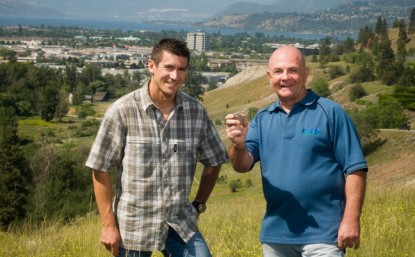
Chad Ulansky cut his teeth on Ekati, Canada’s first diamond discovery, but it’s uranium that he’s hunting for now in Canada’s frozen North.
The Kelowna geologist is president and CEO of Northern Uranium (TSXV:UNO), which is exploring in northwestern Manitoba just beyond the eastern edge of the prolific Athabasca Basin.
Ulansky got his start as a geologist with Chuck Fipke’s Dia Met Minerals, which discovered Ekati, Canada’s first diamond mine, at Lac de Gras in 1991. The discovery by Fipke and Dia Met partner Stu Blusson, which came after years of systematic exploration, rocked the global diamond industry and sparked the biggest staking rush since the discovery of gold in the Klondike.
The Ekati discovery also kick-started the Canadian diamond industry and upset the De Beers cartel. Canada is now the world’s third largest producer of diamonds by value, with four mines and another two under construction.
Last year, Fipke sold his 10% interest in Ekati for $67 million US to Dominion Diamond Corp., which owns 89% of the mine (Blusson retains a 10% interest).
The Fipke-Ulansky partnership began when Ulansky was just a teenager. An avid outdoorsman from a young age, Ulansky met Fipke when the geologist attended a presentation Ulansky gave to a Kelowna scout troop, and the two hit it off. Fipke told him he would call him at the end of the school year.
Sure enough, Fipke phoned in June and offered Ulansky a summer job, a gig that turned into a continuing, decades-long partnership.
Ulansky continued working for Dia Met until its purchase by BHP in 2001.
Along the way, he obtained a bachelor’s degree in geology at the University of Cape Town in South Africa, where he studied under renowned diamond geologist Dr. John Gurney.
Ulansky retained his love of the outdoors while living in Cape Town. In 2001, he set a record for the Three Peaks Challenge, a 50-km mountain running trail that involves ascents of the three major peaks above Cape Town — Devil’s Peak, Table Mountain and Lion’s Head.
URANIUM HUNT
He’s climbing a peak of a different sort as president and CEO of Northern Uranium, which is searching for an economic uranium deposit just outside the Athabasca Basin — home to dozens of competitors.
Northern Uranium has earned a 50% option on the Maguire Lake property from CanAlaska Uranium. The property borders on Saskatchewan and is located along the extension of the Mudjatik Wollaston tectonic zone, which runs southwest-northeast near the Manitoba border. The zone hosts many of the Basin’s major uranium deposits, including Cameco’s Cigar Lake, McArthur River and Key Lake.
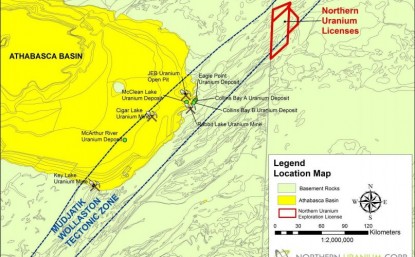
Cigar Lake and McArthur River both have uranium grades above 20%, and Ulansky is out to prove that high-grade uranium exists on Northern Uranium’s property as well.
His thesis is that extensive glaciation stripped off the sandstone and sediments and left basement rock exposed, hosting shallow uranium mineralization.
There is some early evidence supporting his thesis. Prospecting work done by CanAlaska uncovered a boulder that contained 66% uranium oxide, and in situ grab samples have contained grades up to 9% U308.
Finding dozens of mineralized boulders in a small area is highly uncommon, Ulansky says, and Northern Uranium is now searching for the bedrock source of that mineralization.
“What we need geologically is all that uranium in trace quantities across huge volumes of rocks to be picked up and brought to one spot and concentrated there,” Ulansky says, talking about geological changes that occur over millions of years. “The mechanism for that is percolating fluids, waters that circulate through bedrock. When these fluids are slightly oxidizing, they scavenge uranium, they move thru cracks, fissures and preferentially strip out the uranium and carry it with them. The fluids migrate through rocks, when they get to a fault zone that’s permeable, they’ll rise to the surface and cool. Solubility drops and over millions of years, fluids will circulate and uranium will start to precipitate out.”
Northern Uranium has expanded on CanAlaska’s program using various methods — including electromagnetic, magnetic, ground gravity and radon surveys — to narrow down drill targets for a “focused” $1.5-million exploration program.
Airborne magnetics has identified faults that could provide an important pathway for mineralizing fluids, while electromagnetics has identified a 35-kilometre conductor path where precipitation of uranium mineralization is more likely.
RADON RESULTS STELLAR
Radon surveys — which are not being used by all early-stage uranium explorers in the Basin — are among the most useful tools in the hunt for uranium mineralization, Ulansky says.
Just as Fipke used diamond indicator minerals to find Ekati, Northern Uranium is using radon surveys to detect the presence of uranium mineralization.
“The silver bullet for uranium is radon. It’s a gas, highly mobile, very short half-life, that percolates up from uranium mineralization at depth,” Ulansky says.
“Imagine if you were exploring for gold and it uniquely gave off something called gold gas. You’d just go look for the gold gas.”
Radonex, the same company that completed radon surveys for Fission’s high-grade Patterson Lake South project did lake-based radon work for Northern Uranium, and the results were comparable to PLS’s, Ulansky says. Results from the land-based radon surveys were also strong.
However, the challenging part is that the radon signature is much larger than the uranium mineralization associated with it.
“We are very, very strong believers in the fact that there is high-grade uranium mineralization there, it’s just a matter of figuring out where it is,” Ulansky says. “I firmly believe there’s a major discovery to be found, and it’s just a matter of drill testing to find it.”
Watch: Mr. Fipke’s Canadian Mining Hall of Fame 2013 Induction Video
TARGET ZONE IDENTIFIED
Ulansky’s team has zeroed in on an area 3 kilometres wide by 10 kilometres long, centred over Maguire Lake. The target zone is northeast and up ice of the high-grade boulder discovered by CanAlaska.
“The ice direction is from northeast down to the southwest, so it certainly hasn’t come from the Athabasca, which is down-ice,” Ulansky says. “That’s telling us that up-ice there is some exceptionally rich mineralization to be found.”
During the 3 coldest months of winter, crews have been testing priority targets underneath the lake.
Early drilling has hit some uranium mineralization but not in economic quantities, Ulansky says.
Drill results are expected in the coming months, and with $500,000 in the treasury, Northern Uranium will need to raise money to fund more drilling.
Fipke is a special advisor and major shareholder.
“All the geology to date looks exceptionally promising, it’s just a matter of raising the funds to continue drilling,” Ulansky says.
Northern Uranium can earn up to an 80% interest in the project by spending an additional $8.4 million in two tranches and issuing 7.5 million shares and 3.75 million warrants over four years.
Ulansky remains a key player in Fipke’s group of companies; he’s president of Cantex Mine Development and president and CEO of Metalex Ventures. The two companies share Kelowna office space with Northern Uranium, helping keep the burn rate down to $10,000 a month.
The group of companies also own the drill rigs.
The radon and boulder indicators that Northern Uranium has are promising, but now comes the hard part: finding high-grade uranium mineralization. Ulansky compared the exploration effort to trying to break a plate at the bottom of a swimming pool blindfolded, with a pool cue. You know the plate’s there, but to smash it, you have to find it.
If you’re going for that type of swim, the partners you want are Chad Ulansky and Chuck Fipke.
To receive drilling news directly from the company, email info@northernuranium.com with the subject line, “Please add me to your email list.” That or call the company’s Kelowna office at 1.250.448.4110 for more information.
Author has a financial interest in Northern Uranium. The article is not intended to be investment or professional advice of any kind. Readers are strongly encouraged to independently verify all information contained in the article, as it may contain errors. Please see Terms of Use and Privacy Policy for important disclosures. Some of the statements contained herein may be forward-looking statements which involve known and unknown risks and uncertainties. Without limitation, statements regarding potential mineralization and resources, exploration results, and future plans and objectives of Northern Uranium are forward looking statements that involve various risks. The following are important factors that could cause Northern Uranium’s actual results to differ materially from those expressed or implied by such forward looking statements: changes in the world wide price of mineral commodities, general market conditions, risks inherent in mineral exploration, risks associated with development, construction and mining operations, the uncertainty of future profitability and the uncertainty of access to additional capital. There can be no assurance that forward-looking statements will prove to be accurate as actual results and future events may differ materially from those anticipated in such statements. Northern Uranium undertakes no obligation to update such forward-looking statements if circumstances or management’s estimates or opinions should change. The reader is cautioned not to place undue reliance on such forward-looking statements.
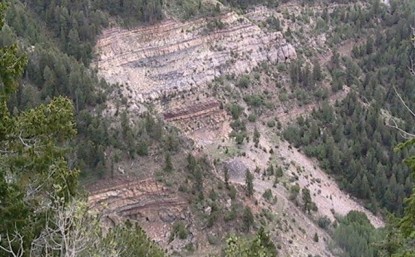
On February 10th, American Sands Energy Corp. [AMSE] provided an excellent corporate update regarding the engagement of Stifel, Nicolaus & Company as its exclusive investment banker and financial advisor. CEO, William Gibbs commented,
“We are excited to be working with Stifel. AMSE is approaching a pivotal point in our development as we work through the permitting process and move towards building our facility and beginning production. Stifel, with its expertise in the energy industry, is a significant addition to our team and we believe will be a great help in achieving our goals.”
I believe the retention of a full service investment bank with a strong reputation in the U.S. is a meaningful de-risking event. For those who don’t know Stifel Nicolaus, please consider the following,
“Stifel’s Investment Banking practice is principally focused on the middle-market. We have twelve industry-focused investment banking groups together with specialty groups providing coordinated financial sponsors coverage and private placement expertise. Stifel has extensive financial advisory and capital-raising experience, having completed over 3,100 public offerings, 900 M&A transactions and 400 private placements since 2000.”
Furthermore, progress towards the completion of permitting appears to be on track. According to CFO, Dan Carlson,
“We received the most recent comment letter from DOGM in early January. We are in the process of responding to the comments and expect to be resubmitting our application by the end of this week [mid February]. Based on the comments, and ongoing conversations with DOGM, the Company believes that we have met all their criteria and hope to finish the permitting process soon.”
I’ve written about American Sands Energy in the past and have routinely outlined what I believe to be the more significant risk factors. First on the list, in terms of timing, is the receipt of all the permits needed. As mentioned above, that risk factor appears to be fading. The second significant risk is obtaining financing for the processing facility. The amount of capital required was recently estimated at $123 million. That is a large figure, but represents the true amount needed to reach commercial production. On one hand, hiring Stifel, Nicolaus is an important step. However, one can not help but notice that the price of WTI Crude has fallen into the $50’s per barrel. Essentially, the oil price is a new risk factor, but one that could possibly be resolved as American Sands moves into production in about 2 years. In other words, I believe WTI Crude will rebound to $80/bbl or higher within 2-3 years i.e when the company should be really humming.
Having said that, the financing is expected to take place in 1h 2015. I still believe that an equity injection could probably get done at a significantly higher stock price after permitting is finalized and with the expert assistance of Stifel Nicolaus. Make no mistake, that capital round will result in meaningful equity dilution. Still, there remains tremendous upside once permitting and funding is in place, both likely in 2015. In my mind it’s a question of when, not if this ambitious project gets off the ground. As a reminder, a portion of the capital needed could come from non-dilutive sources such as project-level investments and equipment financing.
Therefore, this year could amount to a huge amount of de-risking from the completion of both permitting and a capital raise. Then, all eyes will turn to the building of the commercial scale facility to separate sand from the oil bitumen and the mining of ore. I would argue that getting permitting and funding done is a larger hurdle to clear then the mining and the construction of the 9,000/bbl per day facility. While the share price and crude oil price are disheartening, absolutely nothing changes the compelling story of the technology and the flowsheet. Recall that the oil sands in Utah are entirely different from the oil sands in Alberta, Canada. Upon reaching commercial production, operating expenses will be lower than that of the Alberta oil sand operations. Further– upfront capital per barrel of daily production will be a lot less.
That’s why Alberta oil sands companies are cutting cap-ex and people at an alarming and accelerating rate. Much of the oil sands in Canada have costs of $60-$80/bbl. American Sands announced in its February 10th update that its operating cost is estimated at $40/bbl of bitumen. Without going into too much detail, there are ample reasons to believe that global oil prices will rebound smartly in the next few years. Some analysts are calling for $80-$100/bbl crude, others still point to $50-$60/bbl crude in 2 years. Note, few if any analysts forecasted crude oil in the $50’s…
My view, shared by many pundits and analysts, is that much of the oil sands in Alberta will come offline if oil prices remain depressed, and that a significant portion of the U.S shale plays will start to slow as new capital will not be deployed. The shale plays won’t necessarily slow in the next few months, but it’s undeniable that at the current oil price, many planned wells in the U.S. will not see the light of day. Remember the shale oil plays start out strong but decline curves are very steep. In the first year alone, it’s not uncommon for a shale oil well’s production to decline by 50% or more. Therefore, a lot of newly drilled wells could keep supply at a high level for a period of time, but it’s a question of when, not if, crude oil prices rebound.
Finally, many observers of the oil market point out that a number of junior and mid-tier oil companies are carrying a lot of debt and are in serious trouble. When annual reserve calculations are made in March, investors will see a lot of write downs of high cost assets. Debt covenants will be breached. Finally, I should add that rig counts have already fallen dramatically in the U.S and elsewhere. To sum up, the oil price may remain depressed for the next 6-12 months, but the cure for low prices is….low prices. American Sands does not require a higher oil price for a least 2 years. Global demand for oil grows about 2% each year, which amounts to a few million barrels per day. The alleged over-suppy of crude in the markets today is pegged at 2-3 million barrels. As less capital is deployed for new and sustaining existing wells, the glut will be taken care of from natural oil well depletion matched with natural annual global demand of a few million barrels per day.
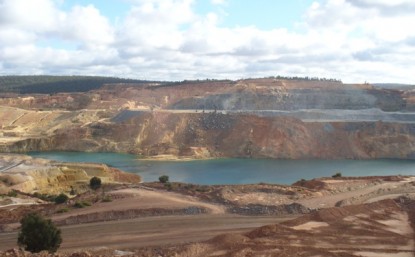
Precious Metals have had an interesting week. Both Silver and the gold stocks rebounded off their 50-day moving averages only to do a 180 the following day. Meanwhile Gold has given back most of its January gains. In this missive we consider the near term outlook for Gold and the gold stocks.
In the chart below we plot Gold and Gold priced in foreign currencies (Gold/FC) which is essentially the inverse of the US$ index. Gold put in a strong rebound, rallying over $150/oz from November through January. That was also its strongest rally in real terms in several years. As we can see, Gold/FC drove that rally as its driving the current decline (to some degree). Gold/FC has a bit more downside to go to reach support. The fact that Gold could not hold above $1240 tells us that Gold will need more time before it can retest trendline resistance. However, Gold’s strength against foreign currencies is a major character change that wasn’t in place during 2013-2014.
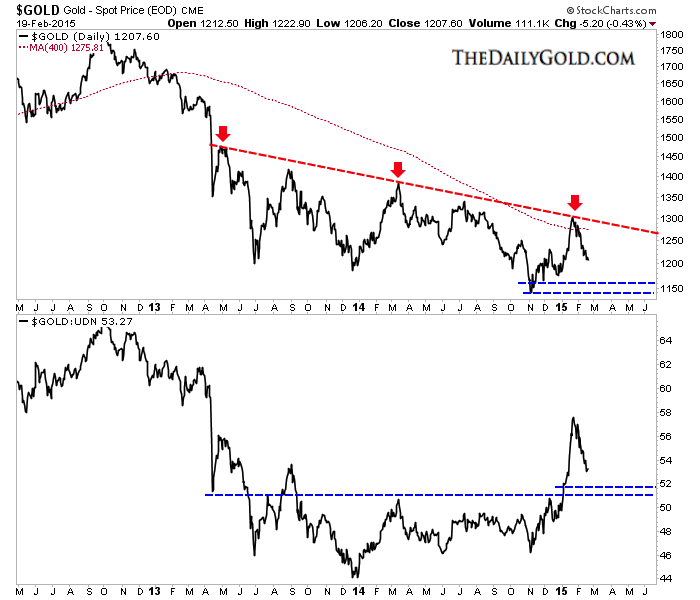
Turning to the stocks, let’s start with the bears analog chart. We use weekly data from the Barron’s Gold Mining Index which dates back to 1938. Back in December we noted that gold stocks were likely at their second most oversold point in history. The most oversold point was the months and weeks prior to the bottom in 2000. Markets can do anything in the short term but this chart makes a strong case that miners are extremely ripe for a new bull market.
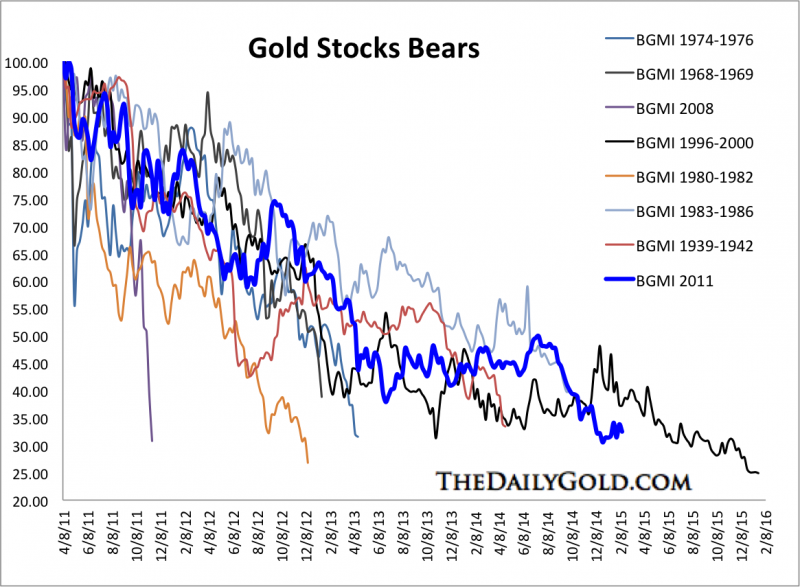
Next is a chart of GDX and our Top 40 Index. Both formed a strong double bottom at the end of 2014 and both will need to surpass their 400-day moving averages to be in a new bull market. The miners formed the recent low amid an extreme oversold condition. After a strong rebound, resistance has come into play. The range between strong support and strong resistance is getting smaller.
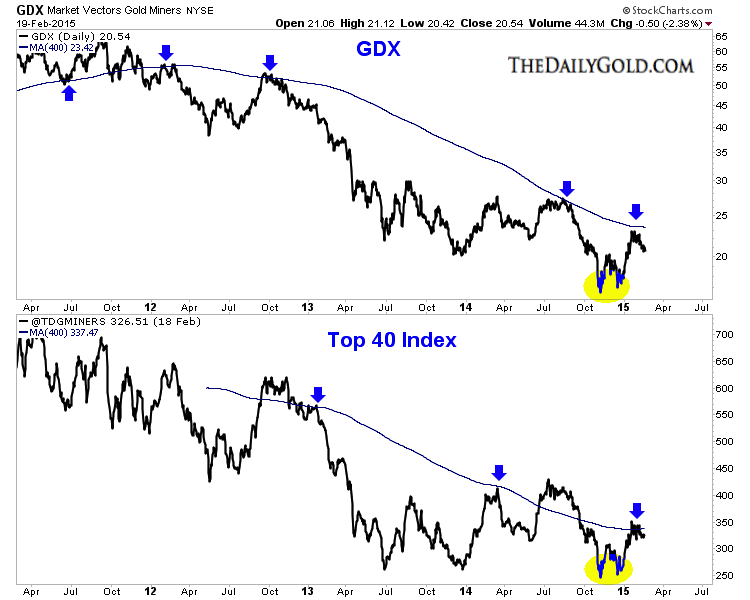
The trend for precious metals can be considered neutral or range-bound with a current bearish bias. After strong rebounds, Gold and gold shares are backing off from resistance. They aren’t yet ready to make major breakouts to lift them into bull markets. This is bearish but there have been key bullish developments in recent months which should caution bears. Both Gold and gold shares performed well amid a very strong US$ which signals a major change. Gold companies are benefitting from the collapse in energy prices and weak currencies within the jurisdictions they operate.
Because gold companies can benefit from lower energy costs and weaker foreign currencies, it’s quite possible that they could be the first, ahead of Gold to break into new bull market territory. Market heavyweights such as Jeff Gundlach and Jim Rogers may sense that as they recently became investors in the miners. A new bull market lies ahead sooner rather than later but investors and traders need to maintain their discipline and patience.
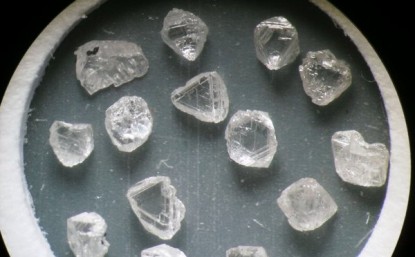
The following article was adapted from the August 27, 2014 issue of Resource Opportunities, our premium newsletter (the video below was taped in December 2014 and just released this morning).
North Arrow is a presenting sponsor at our upcoming Subscriber Investment Summit in Toronto on February 28th, at a truly critical time for the company.
Only a dozen or seats remain at the free conference, so please register now if you intend to be there.
North Arrow Minerals (NAR.TSXV) at a glance:
– Diamond exploration in Nunavut, Saskatchewan, Northwest Territories and Ontario
– Share price: $0.56
– Shares outstanding: 49.8 million
Catalysts:
– Processing of the Qilalugaq Q1-4 bulk sample, which hosts a population of fancy yellow diamonds, is underway and expected to be finished in April 2015. Preliminary indications are that the profile of the bulk sample is consistent with earlier, smaller samples, according to a Jan. 21 news release. A valuation of stones larger than .85 mm will follow processing.
– 3,000-metre drill program at the Pikoo diamond project in Saskatchewan.
Gem Hunting with a Diamond Pioneer
Our goal as junior resource investors is to identify mispriced assets and capitalize on the discrepancy.
Our mission at Resource Opportunities is to identify stocks with an attractive risk-reward profile, where the upside potential more than mitigates any downside risk. We are on the hunt for stocks that could double or triple in the short term, on the way to becoming ten-baggers and more.
Our featured stock in this edition of Resource Opportunities is run by a mining industry legend who delivered 1,000% plus returns to shareholders of his previous diamond play.
He was a first mover during one of the largest staking rushes the world has ever seen, giving his company valuable land positions that led to a world-class discovery.
And he’s back in the hunt, exploring for the same commodity that made him wealthy, in remote terrain that few mineral explorationists know better. His new company has assembled a portfolio of high-quality projects that other companies have spent millions developing. And he’s backed by a deep-pocketed mining tycoon whose multi-billion-dollar empire straddles the globe.
The explorer is Gren Thomas and the stock is diamond exploration play North Arrow Minerals.
The North is Thomas’s favoured exploration terrain, and Arrow describes the trajectory of his Aber Resources stock after the company’s discovery of Diavik. A one-time penny stock, Aber scaled heights of $50 a share en route to deals with Tiffany’s and the purchase of luxury jeweller Harry Winston. Aber’s successor company is Dominion Diamond, which owns 89% of the Ekati diamond mine (after buying Chuck Fipke’s 10% stake) and 40% of Diavik.
Like Mr. Fipke, Gren Thomas is a true pioneer in the Canadian diamond exploration scene.
After Fipke’s landmark discovery, Thomas teamed up with partners – including Christopher Jennings and Bob Gannicott – and quickly staked land to the southeast. They set to work evaluating kimberlite indicator minerals and identifying drill targets.
But diamonds are among the most difficult minerals to find – the geological equivalent of a needle in a haystack – and Aber proved it over the next few years with its fruitless hunt for an economic deposit. Then, in the spring of 1994, a breakthrough. An Aber field exploration crew led by Gren’s geologist daughter Eira Thomas was drilling the final hole before spring breakup, and pulled out core with an almost 2-carat diamond embedded in it – an almost unheard-of occurrence.
Twenty years later, diamonds are still being pulled out of that kimberlite at Diavik – one of the world’s richest diamond mines – and Canada is the world’s third-largest producer of the gems.
In addition to making investors rich and establishing Canada as a diamond powerhouse, Aber’s discovery helped cripple the De Beers cartel that had dominated all facets of the industry – from mining to trading to sales – for more than a century.
But there’s a small problem. The industry built on “Diamonds are forever” is slowly running out of the glittery commodity, just as global demand ramps up. According to Bain and Company, supply is expected to grow by 2% annually over the next 10 years, while demand grows by 5.1% annually – driven by consumer demand in the United States as well as China and India. Few new mines are coming onstream in the next few years.
New Canadian diamond supply is part of the solution. Gahcho Kue in the Northwest Territories is the largest new mine coming on-stream. It’s a 51-49% joint venture between De Beers and Mountain Province Diamonds (MPV.TO) that is slated to open in 2016, while Stornoway’s smaller Renard mine in Quebec is scheduled to begin commercial production in 2017.
Robust Canadian diamond exploration is also part of the longer-term solution. Interest in the sector is reviving as diamond veterans and new players alike head north to identify diamondiferous kimberlites and seek their fortunes. Analyst coverage is also on the rise – both Dundee Capital Markets and Barclays released extensive diamond research reports in 2014.
On the exploration side, Kennady Diamonds (KDI) was the rock star, for a while. Kennady was spun out of Mountain Province and owns the Kennady Lake North project adjacent to Gahcho Kue. The company is developing four diamondiferous kimberlites that are showing great promise, but the stock has hit some headwinds, dropping to $3.79 from highs of $8 in the fall. Kennady has a deep-pocketed major shareholder – Irish billionaire Dermot Desmond, who owns 37% of S.O.
Another notable junior explorer is Peregrine Diamonds (PGD), which boasts Canada’s highest-grade advanced-stage project in Chidliak, its flagship Baffin Island play, as well as impressive stone values. Peregrine also has the Friedland brothers in its corner, with a combined stake of about 34%. If a mine is built at Chidliak, the upside would be substantial, but this stock could severely test your patience in the meantime.
Most of Canada’s other diamond exploration plays are either early-stage or bolted on to producers. Canterra Minerals (CTM) is run by Randy Turner, who discovered De Beers’ Snap Lake mine and is exploring again in the same neighbourhood, while Margaret Lake Diamonds (DIA) has a land package adjacent to Kennady’s, and flew a gravity survey last year. Dominion Diamond (DDD) and Stornoway Diamonds (SWY) also have exploration projects.
Enter North Arrow Minerals and its chairman, Gren Thomas. Before interest in Canadian diamond exploration perked up again, Thomas optioned several “orphaned” properties, including three in the Stornoway Diamonds’ exploration portfolio. Thomas’s daughter Eira, currently CEO of Kaminak Gold (KAM), is a Stornoway cofounder.
North Arrow shares jumped from 40 cents to the 70-cent level in the days following the company’s Nov. 5, 2013 announcement of drill results from Pikoo, an east-central Saskatchewan project optioned from Stornoway. A 210-kg sample of drill core from PK150, the first kimberlite North Arrow discovered there earlier in 2013, returned 745 diamonds larger than the .106 mm sieve size, including 23 diamonds larger than .85 mm.
It was an exceptional result from such an early-stage project, fuelling optimism that North Arrow has an economic deposit on its hands. As Gren Thomas puts it, “we know enough about it now that we can say this thing, if there’s enough tonnes, it can be commercial.” North Arrow hit kimberlite in 9 of 10 drill holes completed on the property. Geologists spent the rest of last year collecting and evaluating 560 till samples to help define new drill targets, including several new kimberlite indicator mineral trains. A 3,000-metre drill program is now underway.
North Arrow earned an 80% share of the project from Stornoway, which retains 20% and passed on a one-time back-in right to acquire another 20%.
North Arrow’s most interesting property is the unpronounceable – and under-the-radar – Qilalugaq (kill-a-loo-gah-ck) project near Repulse Bay, Nunavut. North Arrow has optioned 80% of Qilalugaq, another of Stornoway’s “orphans,” but Stornoway retains a one-time back-in right to acquire another 20% of Qilalugaq by paying North Arrow three times its exploration costs. Over $25 million has been spent developing the property, which was originally staked by BHP Billiton Diamonds, so North Arrow is leveraging large amounts of cash spent by others.
Qilalugaq has size – its 12.5-hectare Q1-4 kimberlite is the largest diamondiferous kimberlite pipe found in the eastern Arctic. Qilalugaq is advanced – Q1-4 has an inferred mineral resource estimate of 26 million carats from 48.8 million tonnes of kimberlite, for an average diamond grade of 53.6 carats per hundred tonnes (low by Canadian standards but comparable to some of Renard’s pipes). And Qilalugaq has location – it’s 7 kilometres from tidewater.
Most importantly, Qilalugaq has rare yellow diamonds. Fewer than 0.1% of all diamonds are yellow, and fewer still are the yellow diamonds so vivid and intense they can be classified as “fancy yellows.” Colour is one of the 4 Cs of diamond grading, along with carat, clarity and cut. High-quality coloured diamonds command top prices.
How significant is the presence of yellow diamonds to diamond values? Consider the Ellendale mine in Australia, which is owned by Kimberley Diamonds. Ellendale is the world’s leading source of fancy yellows, contributing about half of the world’s supply from a depleting reserve. Ellendale’s fancy yellows make up only about 15% of total carats sold, but a whopping 80% of the company’s revenue.
No wonder North Arrow chairman Gren Thomas calls Qilalugaq “a potential company maker.”
Until recently, Kimberley sold all its fancy yellows to Tiffany’s – the luxury jeweller that had a relationship with Aber, continues to source diamonds from Aber successor Dominion Diamonds and has viewed some of North Arrow’s yellow diamonds. However, Kimberley announced Aug. 22 it would display 750 carats of its fancy yellows from Aug. 28 to Sept. 9 and sell them at auction on Sept. 10. Wonder if anybody from North Arrow stopped by to compare notes?
North Arrow has collected a bulk sample of more than 1,500 tonnes of kimberlite to determine size distribution, what proportion of Q1-4’s diamonds are yellow, and the quality of those yellows. The bags of kimberlite were shipped out on the annual sealift that arrived in Repulse Bay late last Summer. Processing began in October in Thunder Bay and North Vancouver, after which about 500 carats of the Q1-4 diamonds will be flown to Antwerp for independent evaluation. The results of that valuation are expected in the second quarter of 2015. That’s when Stornoway will have the one-time back-in right to an extra 20% of the project.
During our recent interview with North Arrow president and CEO Ken Armstrong, he helped set expectations for the diamond value. Operating Canadian diamond mines are typically in the order of $100 to $500 per carat, and a result of greater than $150 per carat would be significant for the small company.
“If we get a high valuation, then it immediately becomes a development track project with a pretty clear path for further evaluation,” Armstrong said. “We would enter into completing a preliminary economic assessment. The next field work would be more drilling, upgrade the resource to measured and indicated status, drill some deeper holes, some glory holes to 600 meters … to see if the kimberlite is still down there … and then following that up pretty quickly with a larger bulk sample … The project could be on its way, and it could happen very fast.”
North Arrow shares – which some days, don’t trade at all – are at about the same level they were when Resource Opportunities initiated coverage on Aug. 27.
But North Arrow chairman Gren Thomas has increased his ownership level since then – exactly what we like to see when a company’s stock does not reflect a company’s operational progress. Since Aug. 27, Thomas has purchased more than 380,000 North Arrow shares in the public market at prices ranging from 47 to 60 cents, according to INK Research. He owns about 6 million shares, a 14.3% stake.
North Arrow’s largest shareholder is a Lundin family trust, which owns about 23% of the stock. Billionaire Lukas Lundin has deep pockets and an outstanding track record of creating shareholder value, including at his dividend-paying African diamond producer Lucara Diamond (LUC.TO), which has a market cap approaching $800 million. Eira Thomas is one of Lucara’s largest individual shareholders. Lundin has participated in recent North Arrow equity offerings on a pro rata basis, most recently in February 2014 (at 65 cents). With Lundin as a supportive shareholder, raising more cash for exploration programs shouldn’t be a problem.
The links between North Arrow and the Lundin Group’s Lucara run deep. Eira Thomas is a Lucara director, was key to the formation of Lucara and owns about 2% of outstanding shares, while Lucara CEO William Lamb sits on North Arrow’s board of directors. “Lucara’s an outstanding diamond company, and I’m hoping of course we can do something similar with North Arrow here,” Gren Thomas told me.
With about 50 million shares outstanding, about $5 million in cash (as of October 31) and the stock at 56 cents, the market is assigning North Arrow Minerals an enterprise value of just $23 million. If even one of North Arrow’s projects proves economic, the company’s market capitalization should correct to multiples of that number.
We contend that North Arrow Minerals is a mispriced asset offering a better-than-average shot at dramatic share price appreciation. If that happens, we don’t know when it will happen. North Arrow is also a volatile and thinly traded stock.
However, the lack of liquidity on this closely held stock is a double-edged sword that works in your favour when good news comes out, as illustrated by the share price action following the Pikoo discovery in early November 2013. Gren Thomas and Lukas Lundin are unlikely to sell in the event of bad news, which offers some protection on the downside.
Because investing in diamond exploration plays is such a high-risk venture, a basket approach mitigates risk. But if we had to own a single diamond exploration stock, that stock would be North Arrow Minerals.
Watch our interview with North Arrow chairman Gren Thomas here.
Watch CEO Ken Armstrong discuss the Pikoo project here.
Sign up for North Arrow’s email list here.
Author is a shareholder in North Arrow Minerals. This is not intended to be investment advice of any kind and readers are strongly encouraged to do their own due diligence and consult a professional investment advisor before making any investment decision. This article and video contains “forward-looking statements” including but not limited to statements with respect to North Arrow’s plans, the estimation of a mineral resource and the success of exploration activities. Forward-looking statements, while based on management’s best estimates and assumptions, are subject to risks and uncertainties that may cause actual results to be materially different from those expressed or implied by such forward-looking statements, including but not limited to: risks related to the successful integration of acquisitions; risks related to general economic and market conditions; closing of financing; the timing and content of upcoming work programs; actual results of proposed exploration activities; possible variations in mineral resources or grade; failure of plant, equipment or processes to operate as anticipated; accidents, labour disputes, title disputes, claims and limitations on insurance coverage and other risks of the mining industry; changes in national and local government regulation of mining operations, tax rules and regulations. Although North Arrow has attempted to identify important factors that could cause actual results to differ materially from those contained in forward-looking statements, there may be other factors that cause results not to be as anticipated, estimated or intended. There can be no assurance that such statements will prove to be accurate, as actual results and future events could differ materially from those anticipated in such statements. Accordingly, readers should not place undue reliance on forward-looking statements. Always do your own due diligence.
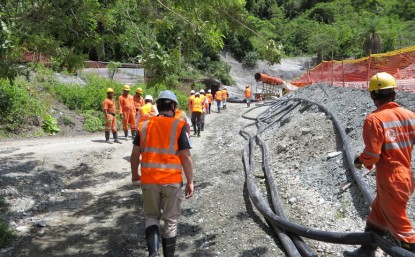
Via EnergyandGold.com, The mining industry is continually depleting its inventory, which is why it has always been an M&A led business. Junior companies find and develop new deposits and then mid-tiers and majors take them out. This has been the way of the miners for generations.
There are few undeveloped high quality gold projects in the world currently, especially those that offer potential scale and long life. Even fewer of these deposits are high grade. Continental Gold’s Buriticá gold and silver project in Colombia is one of the richest gold deposits in the world, consistently ranked among the top gold development stories in the world by analysts. We had the opportunity to interview CEO Ari Sussman by Skype on Thursday, for an update on the exciting Buriticá project.
Scott Armstrong: Please put Continental Gold’s Buriticá project in the context of other undeveloped gold deposits out there? How does it stack up?
Ari Sussman: We are at the forefront of Colombia gold exploration and development and although I say we are at the forefront, Colombia as a country has a rich tradition in gold mining. In fact, Colombia is the oldest and richest producer of precious metals in Latin American history. The gold museum in Bogota is one of the great things to see if you are a precious metals buff, it has pieces dating back hundreds of years. It’s definitely worth visiting and seeing if you ever make it to Colombia.
The story of Colombia is really interesting and is full of geological potential. People get confused when they think of mining in Colombia and ask why weren’t there other major discoveries made over the past 30 years, prior to the very recent exploration successes. The answer is that Colombia went through a very difficult period of troubled security problem which inhibited foreign direct investment into natural resources. However, until former President Uribe and current President Santos There has been a drastic improvement and so what do we have in Colombia now? We have a country with as good of a political regime as exists in Latin America for foreign business practices to operate. In fact the Government political alignment has been pro-business oriented for more than 40 years. Couple this with an ever improving security situation since the turn of the century and you have an excellent opportunity to make resource discoveries.
Why do we like Colombia geologically? Well the obvious reason is the Andes mountain chain continues through Colombia and it turns out there has been little modern exploration done for metals, not just gold but for base metals and oil as well.
Additionally, Colombia sits above a triple plate junction where 3 tectonic plates coalesce. Some of the worlds largest mines are located in other countries with this setting style. It’s clear we’re at the beginning of a gold exploration renaissance, which of course has been through a difficult period during the past three years. However, similarities in this regard can be made to Peru from 1997-2001 or Chile a decade earlier. In fact, this gold renaissance only began in 2006 and I get asked this question a lot “Colombia, there’s really not a lot to show so far. There’s no new mines that have been built and nothing’s happened in Colombia.” I say wait a minute people, the average mine today from discovery to production is 18 years! That’s the timeline globally. From 2006 until today what has happened in Colombia in gold? You have our Buriticá Project which is 7,000,000 ounces of gold at high grade in all categories which is going to grow to well north of 10,000,000 ounces. You had a company called Ventana Gold which at the time of its purchase was around 3.5-4.0 million ounces. Eike Batista bought it and now it is purported to be north of 15,000,000 ounces. Lastly, you have AngloGold Ashanti, which made a discovery called La Colosa that is expected to grow to over 30,000,000 low grade ounces. All of these ounces were discovered from grassroots, with a much higher than average discovery rate based on meters of diamond drilling completed compared to most other countries within this very short time frame.
Our Buriticá project is the one that is going into production first. We are aiming to commence production in late 2017 or early 2018. We took over this project and started putting money into it in early 2010 which is when we listed on the TSX. So 8 years or so to reach production is a lot faster than the average project globally at 18 years. So there’s actually been excellent success in Colombia in a short time frame. Now obviously Colombia has suffered since 2011 when commodity prices peaked, but so has everywhere else in the world. As a consequence money has dried up and exploration efforts have slowed drastically. Most companies that didn’t find potentially economic projects have left the country to do something else. Today we are entering the smarter money phase in Colombia. This is the phase where we are starting to see deep pocketed majors with significant exploration budgets now looking aggressively to make or acquire discoveries of large-scale. Then there’s us at Continental Gold with our Buriticá Project and also our portfolio of earlier stage projects behind it which we think offer excellent potential.
Scott Armstrong: Is your plan at the Buriticá Project to develop the project to production yourself?
Ari Sussman: We would like to develop the project ourselves and have the team in place to do so but shareholder value comes first and we will ultimately pursue the path that is in the best interest of shareholders. I get asked a lot if we will sign confidentiality agreements (CAs) with other companies and I’ve always maintained that we will not entertain signing CAs until after we permit the project. The precedent has always been very clear in Latin America if you do sell a project the best value obtained is generally after permitting has already been completed.
Scott Armstrong: So where are you on the permitting front?
Ari Sussman: In Colombia you need a mining license and an environmental license to produce gold. We received our mining license in 2013, that’s a 30 year license, so we’re finished in that regard. Still outstanding is the environmental license and our guidance for completion of that has been for mid-2015 and we are on target to meet that guidance. So in a few short months we do expect to be permitted, sometime in the summer time.
Scott Armstrong: What are the biggest challenges for Continental?
Ari Sussman: There’s two sets of challenges: The actual challenges on the ground with the project and then there’s the perception challenge. Let’s take the perception challenges first. The perception of the market on Colombia is that you cannot permit projects and that is just dead wrong. It’s due to an unfortunate event involving a specific instance where a company was denied an environmental permit because they were operating on land, which at the time was deemed to be in a national park. That is a one off case and that’s an important point to make. If you look at Colombia there are dozens of small gold mines that are permitted and operating in the country. Also, the world’s largest open pit coal mine produces profitably in Colombia, along with many other large coal mines. BHP operates a very large nickel mine which, at one point, was the world’s largest nickel mine. The point is, Colombia has a tradition of permitting environmentally and socially responsible projects yet perception remains negative. However, once we get our permit I can assure that Colombia will be viewed as the country where you CAN permit, not the country in which you cannot.
The challenges which we have with the project itself, well it’s an underground mine so obviously there’s a lot of engineering that has to happen to bring this project to fruition. Our plan is to complete a feasibility study in mid-2016 and that will be our financing and construction decision point for Buriticá. However, if you follow our company you saw we announced a PEA (preliminary economic assessment) late last year and it was in the lowest quartile (costs) rendering it one of the higher quality unbuilt projects in the world. Our post-tax IRR was 31.5%, our net present value at a 5% discount rate was $1.1 billion and we outlined an 18 year mine life which produced well north of 300,000 ounces of gold per year in the first five years. It is a very robust high-grade project with modest capex and being underground, it will utilize a small footprint of land.
The real key to Buriticá, which I think is very important for investors to understand, is the scale of the project. Buriticá, hosts two vein systems side-by-side, which boast a remarkable vertical dimension. In fact, both vein systems have been drill tested down to 1.8 kilometers and remain open at depth. Also, both vein systems boast lateral strike lengths of at least 1 kilometer. Yet, the individual veins that were included in our resource estimates have much smaller dimensions than this. The reason for this, for the most part, is due to lack of drilling and we are confident that we are going to grow to well north of 10 million ounces of gold plus silver in time.
Scott Armstrong: Aside from the challenging overall market environment for junior explorers, how do you explain the poor stock price performance? What are investors not understanding?
Ari Sussman: I think it mainly has to do with this fear of not being able to permit. We are trading at a discount to our peers for the first time in a very long time, we had historically always traded at a premium given the quality of the asset and the high grade. I think this makes an excellent entry point for someone because of this discount and if you’re willing to bet on the company’s ability to deliver a permit as well as deliver overall growth of the resource I think the future looks quite bright. I should mention as well that we will be coming out with an updated resource estimate in the May/June time frame. We are looking to improve the internal quality of it, which means conversion of inferred ounces to the indicated & measured category. Also, we expect to deliver overall growth in terms of the total number of ounces of gold while maintaining the high grade status of the project.
Scott Armstrong: How much cash do you have, and what were the financing prices?
Ari Sussman: We have $67 million dollars US in the bank as of November 5th, 2014 and have a $30 million budget for calendar year 2015. We have enough cash to make it through the feasibility study in mid-2016 at which point we will go for project financing. The last financing was done in November of 2012 at $9.55/share.
Scott Armstrong: What is Continental missing in terms of infrastructure in Colombia right now?
Ari Sussman: We’re in a very infrastructure rich area, you drive to our project on the Pan-American highway and there is abundant electricity available in the area. But what are we missing in terms of infrastructure? The milling part of the site is going to be built at the base of a mountain and we need to bring a 6 kilometer paved road down to it, a short distance indeed.
Scott Armstrong: What should investors expect from Continental during 2015 in terms of milestones and accomplishments?
Ari Sussman: #1 Environmental permit #2 Updated resource estimate #3 Updated PEA during the 2nd half of the year #4 Drilling of new targets which I think is a big catalyst assuming we make a discovery of course and #5 We plan to list our shares in Colombia on the exchange.
Scott Armstrong: What kind of operating leverage will Continental have to a rising gold price and what is your all-in cost range on the Buriticá Project?
Ari Sussman: In our PEA we published costs, we didn’t do all-in sustaining costs because we don’t know all the variables yet. But total cash costs amounted to $389/oz for the first 5 years and about $415/oz over the life of the mine, these are lowest quartile numbers.
Scott Armstrong: Could you update us a bit on the security situation in Colombia?
Ari Sussman: Current estimates are that about 80% of the rural countryside in Colombia is safe to operate. There are some security hot spots left but these locations are generally well known and are away from more heavily populated areas. The main point with respect to security is that the statistics have been improving for years, in contrast to other countries in Latin America which are heading in the opposite direction.
Scott Armstrong: Are there any other juniors in Colombia which have caught your eye recently?
Ari Sussman: There are two. One is Red Eagle (RD.V) which is going through the permitting process as well and expects to complete permitting their proposed small gold mine at approximately the same time as Continental on roughly the same time schedule as for a proposed small gold mine at roughly the same timeline as Continental. Also, I want to mention Cordoba Minerals (CDB.V) of which Continental is a shareholder of and I represent it’s interest as Chairman of the Board. Córdoba has locked up a large land package covering a new porphyry belt in an area of excellent infrastructure. The Company made a grassroots discovery last year with some fantastic drill results including a hole at over 100 meters averaging well over 1% copper equivalent. This is a great early stage opportunity with a beaten up share price, there lots and lots of targets here if you are comfortable investing at an early stage.
Thank you for your time Ari and we look forward to following Continental Gold closely over the coming years as you move the Buriticá Project forward to production. Best of luck in 2015 to you and Continental!
Scott Armstrong of EnergyandGold.com, Guest Contributor to MiningFeeds.com
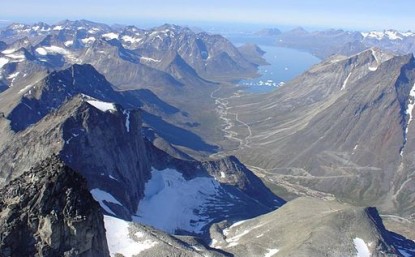
For the most part positive fundamentals (for gold mining companies) refers to rising Gold prices. However, this neglects the things under the surface which can affect margins as much as headline prices and in some cases more.
In the chart below we plot Gold priced in Canadian Dollars, Gold against Oil and Gold against Industrial Metals. Before we get to the chart let me explain why these ratios are important. First, the vast majority of gold mining firms are headquartered in Canada. The loonie is their local currency. The Canadian Gold price for firms that operate mines in Canada or explore in Canada can be more important than the US$ Gold price because their costs are in Canadian Dollars and not US$’s. Thus, a weak loonie rather than a weak US$ is a benefit.
Second, the Gold/Oil ratio is important because energy costs can account for 25% of a miner’s costs. Mining is an extremely energy intensive activity.
The chart below shows that the Gold price in Canada has surged while the Gold/Oil ratio has exploded. We also plot Gold against Industrial Metals as a proxy for other industrial related mining costs. That ratio has increased materially in favor of Gold but not to the degree of the other ratios.
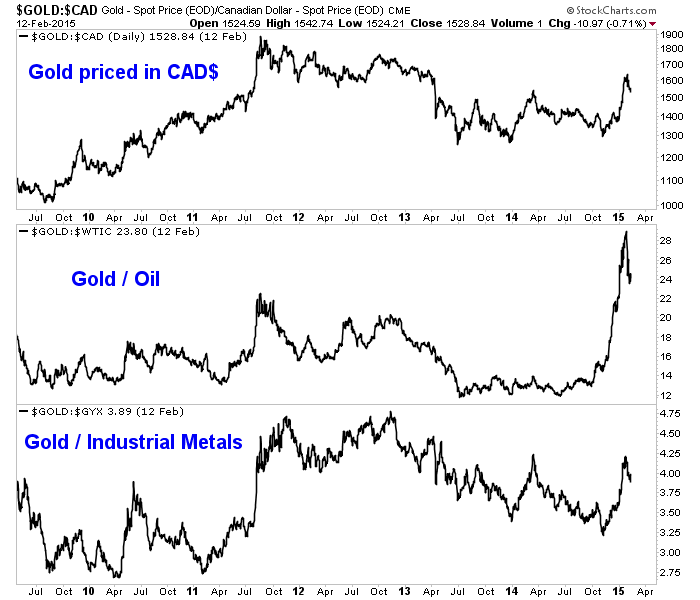
As evidenced by GDX, the miners formed a strong double bottom and rebounded to the 400-day moving average which is key bear market resistance. The miners did not have that type of support at other lows (such as in June 2013 and December 2013). Moreover, the miners did not have improving margins thanks to plunging energy prices and a much weaker local currency.
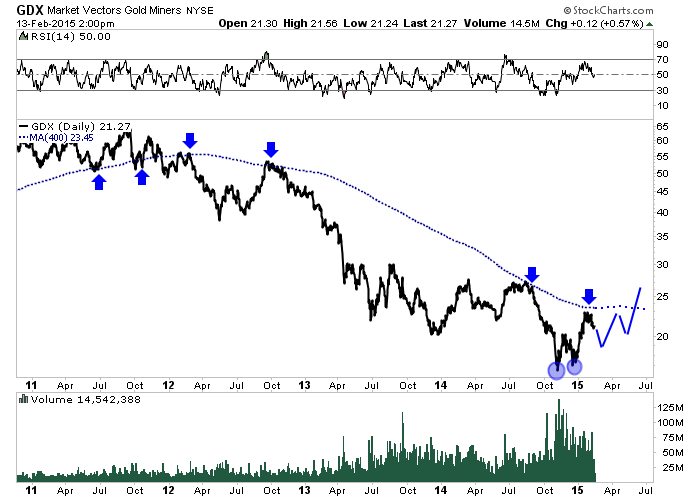
The miners have made progress in recent months but the bear market won’t be over until GDX can clear its 400-day moving average. The good news is the miners formed a bullish double bottom after reaching arguably their second most oversold point (from a long-term sense) in the last 70 years. That was followed by the positive developments discussed above and word that the likes of Jeff Gundlach and Jim Rogers became investors in the sector. A new bull market lies ahead sooner rather than later but investors and traders need to maintain their discipline and patience.
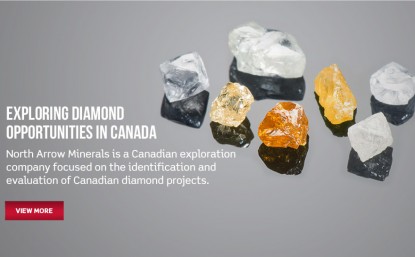
North Arrow Minerals (NAR.V) is a promising diamond exploration company with a portfolio of projects in Northern Canada.
The company has extremely successful backers in the diamond industry, with Gren Thomas serving as Chairman, and his daughter Eira Thomas acting as an advisor to North Arrow. The Thomas’s led the Diavik diamond discovery in the early 1990s. Additionally, world renowned natural resources developers, the Lundin Group, led by patriarch Lukas Lundin, are major shareholders in the junior company. Mr. Lundin is coming off a big success building the Karowe diamond mine in Botswana with his Lucara Diamond Corp, and has been looking for assets to expand the company.
North Arrow’s highest priority project, Qilalugaq in Nunavut, is currently undergoing a bulk sample and diamond value, with results expected in the next quarter that could be transformational for the small company.
North Arrow’s second highest priority project, Pikoo in Saskatchewan, is a bonafide diamond discovery of its own.In 2013, the company drilled 2000 meters at Pikoo, hitting kimberlite in 9 of 10 holes, and finding significant quantities of commercial sized diamonds (news release here). These were some of the most promising initial diamond results in the history Canada’s diamond business.
“It’s a really good start,” CEO Ken Armstrong said during a December 2014 interview. “Textbook really.”
The company spent 2014 conducting two till sampling campaigns at Pikoo, generating 2-6 distinct new targets at the head of kimberlite indicator mineral trains.
Earlier this week, North Arrow commenced a 3000 meter drill program at Pikoo. The program will test some of the new targets, and continue to test the area around the 2013 discovery, known as PK-150.
If drilling hits kimberlite, samples will be then tested for diamonds. Results are expected throughout the Spring.
North Arrow shares hardly traded this week, which goes to show just how dead Canada’s mining markets are.
I am a shareholder in the company and have been covering it in our Resource Opportunities newsletter ($299/yr), and they are a sponsor of our upcoming Subscriber Investment Summit in Toronto on February 28, 2015. There are just a few spots left and we urge loyal CEO.ca readers to attend (Registration link).
Here’s a link to this week’s news release: North Arrow Drilling Program Underway at Pikoo, Saskatchewan
Sign up at North Arrow’s site to be first to hear of the results and keep your eyes on the company this Spring.
This is not intended to be investment advice of any kind and readers are strongly encouraged to do their own due diligence and consult a professional investment advisor before making any investment decision. This article and video contains “forward-looking statements” including but not limited to statements with respect to North Arrow’s plans, the estimation of a mineral resource and the success of exploration activities. Forward-looking statements, while based on management’s best estimates and assumptions, are subject to risks and uncertainties that may cause actual results to be materially different from those expressed or implied by such forward-looking statements, including but not limited to: risks related to the successful integration of acquisitions; risks related to general economic and market conditions; closing of financing; the timing and content of upcoming work programs; actual results of proposed exploration activities; possible variations in mineral resources or grade; failure of plant, equipment or processes to operate as anticipated; accidents, labour disputes, title disputes, claims and limitations on insurance coverage and other risks of the mining industry; changes in national and local government regulation of mining operations, tax rules and regulations. Although North Arrow has attempted to identify important factors that could cause actual results to differ materially from those contained in forward-looking statements, there may be other factors that cause results not to be as anticipated, estimated or intended. There can be no assurance that such statements will prove to be accurate, as actual results and future events could differ materially from those anticipated in such statements. Accordingly, readers should not place undue reliance on forward-looking statements. Always do your own due diligence.
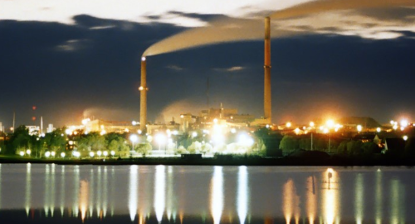
Note, the opinions contained in this article are entirely my own. I am not an insider of Falco Resources, nor am I in possession of any non-public information. The information contained herein was obtained by reading company press releases, the February, 2015 corporate presentation and an informative video clip of CEO Trent Mell.
Impressive De-risking and Growth Announced by Falco Resources
On February 10th, Falco Resources (FPC.V) & (FPRGF) provided a road map for 2015. Not only is the company advancing its work on its flagship Horne Au-Ag-Cu-Zn project in Quebec, it has officially announced an aggressive drilling campaign with a budget of $3.7 million. The Horne Project area encompasses the former producing Horne and Quemont mines as well as the Horne 5 deposit. The Horne mine was operated by Noranda from 1927 to 1976 and produced 11.6 million ounces of gold and 2.5 billion pounds of copper. The Quemont mine is located 600 metres north of Horne and produced approximately 2 million ounces of gold and 400 million pounds of copper between 1949 and 1971. The Horne 5 deposit lies immediately below the historical Horne mine.
Together, Horne and Horne 5 share many similarities to Agnico-Eagle’s La Ronde mine located 40 kilometres to the east. Those orebodies are dynamic multi-metallic systems that remain open, plunging steeply to depth for several kilometers. How many juniors can one name spending $3.7 million on drilling alone? By the time initial metallurgy results come back at mid-year, a lot of juniors could be out of business, unable to afford the annual audit fees. Last I checked, auditors don’t accept shares in the companies they audit. Recall from prior articles I’ve written [Here] & [Here] that Falco essentially inherited a 2.8 million gold equivalent Inferred resource due to an extensive database containing roughly 80 years of Noranda’s exploration, development and production records on 14 past-producing mines.
Up to 5 Million Gold Equivalent Ounces by Year-End Could be a Game-Changer
This Inferred resource was delineated without a single drill hole by Falco and supports management’s ambitious plans to book up to 5 million gold equivalent ounces in the NI 43-101 categories of Indicated & Inferred in the 4th quarter. A takeaway from the February 10th press release is a reminder that the company is fully funded through 2015. Even if one does not actively support a takeout thesis, the value creation and de-risking from achieving 2015’s stated corporate initiatives could be a meaningful catalyst for the stock price. Comparing Falco’s exploration project to that of neighboring mines, 2 out of 3 analog mines (Agnico-Eagle’s Goldex and AuRico’s Young Davidson) have considerably lower ore grades and less than Flaco’s projected 5 million ounces of gold equivalent resources.
Although there was no groundbreaking news in Falco’s corporate update, I believe that it’s not only helpful for investors, but also for prospective acquirers of Falco. The initial results of metallurgy testing to establish recoveries for Au, Ag, Cu, and Zn due by mid-year, could be as important a catalyst as the next NI 43-101 resource update. Why? Because potential suitors need to check off a number of boxes before they get really interested. Some of those boxes may already have been checked, most notably that the company’s property being in an excellent jurisdiction with substantial access to infrastructure / labor and Falco having tremendous exploration upside outside the Horne land holdings.
Prospective Suitors Most Likely Watching Falco Very Closely
Of course, suitors start kicking tires at different stages. However, I would not be surprised if some potential acquirers are already doing due diligence, or at least following Falco’s progress quite closely. Yet, I don’t believe that Falco’s shares are trading at a premium due to a possible takeout scenario. Falco’s stock at $0.54, is up 12.5% from the news of Osisko Gold Royalties wielding a more aggressive stance with its ownership of 10mm + shares, and Osisko raising $200 million to refinance its credit facility, thereby maintaining a sizable war chest. Please recall that Falco controls the last, and a giant property in the Abitibi Greenstone Belt. Yet, a 12.5% gain on the then $40 million market cap equates to roughly a $5 million valuation uptick for a well funded company that could be worth well over $100 million within 12-18 months.
Without belaboring my takeout thesis, which again can be found [Here], it seems undeniable that Falco is becoming more and more valuable as some of the key de-risking events outlined in the February 10th press release come to pass. Of course, management has to execute by hitting their exploration and metallurgy testing milestones, but the company is lucky to have a top-tier management team and Board. The profile of the Board and management teams is unlike most junior mining companies, as it’s made up of people who have built and operated some of the most successful mines in the Abitibi, including Agnico-Eagle, AuRico Gold and Osisko Gold Royalties. It’s a real tribute to the quality of Falco’s asset base that it has been able to attract this magnitude of relevant and extensive experience. I recognize of course that every junior miner on the planet says that they have a strong management team. Therefore, I invite readers to make their own determination by clicking [here] for more details.
Falco’s Market Cap Well Within Reach of Mid-Tier & Major Gold Players
Remember, this is a company with a market cap of about $C 50 million, a drop in the bucket for peer Abitibi Greenstone Belt players like Goldcorp, Agnico, Yamana, Hecla and AuRico. Sometimes larger companies acquire an attractive, long-dated call option on the price of gold for themselves and/or to block that call option from falling into the hands of peers. If Falco can execute, there could be competitive tension among suitors such that multiple parties become interested in Falco’s assets later this year. Okay, now admit I am belaboring my takeout thesis!
Switching gears, questions that I’ve been asked subsequent to my latest articles sometimes revolve around the assumption that 1) Noranda already mined the low hanging fruit and that 2) subsequent companies had opportunities to mine after Noranda did, but decided to pass. It’s very important to remember that Noranda was a copper producer, and they built a large copper smelting complex in Rouyn-Noranda in the 1920s. The mandate of the Company was to feed copper to the smelter. Gold was not important and was only produced as a byproduct of copper production.
Falco’s Extensive Database and Highly Prolific Historical Production Bode Well for Next NI 43-101 Report
Despite never being a focus, the camp produced 19 million ounces of gold (along with almost 3 billion pounds of copper) making it amongst the most prolific gold camps in the Abitibi during the 50-year operating life of the Horne mine from 1927-1976. With consolidated property, a strong management and Board, $12 million in cash, a tremendously valuable database and enhanced modern exploration and development technologies, I believe that Falco’s ambitious goal of ending the year with up to 5 million NI 43-101 compliant gold equivalent ounces is not as lofty a goal as some might suspect. Promising initial metallurgy results would be a welcome event as well. Near term catalysts are the release of assays, the metallurgy testing, finishing drilling in 3q 2015 and of course an updated NI 43-101 resource report. I remain very bullish on Falco Resources and strongly recommend that prospective investors review the company’s corporate presentation and recent press releases.
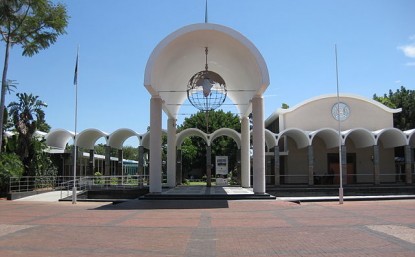
Galane Gold Ltd. (GG.v) (GGGOF) is an unhedged gold producer and explorer with mining operations and exploration tenements in the Republic of Botswana. The company is committed to operating at world-class standards and is focused on the safety of its employees, respecting the environment, and contributing to the communities in which it operates. Galane has been producing gold from the Mupane operation since 2005. Galane’s operations are just an hour’s flight from Johannesburg and are endowed with the infrastructure to produce up to 50,000 ounces of gold per year. 2015 is an especially good time to consider an investment in this undervalued company.
Gold Companies Like Galane Gold, Currently in Production, Warrant a Premium Valuation
Gold companies that are currently in production, generating free cash flow warrant a premium valuation to those in development. Intuitively we all know this to be the case. The leap to production from development is much more difficult then investors recognize. In many cases, development companies still need to raise large sums of capital, which is no easy feat in today’s financing environment. Even if successful, development companies remain in the mode of repeated equity dilution or entering into expensive and risky debt arrangements with onerous debt covenants.
However, the challenges don’t end with obtaining financing, a development company has to hire an operating team, get final permits, foster a strong social license to operate with locals, nail down all of the infrastructure (roads, airstrips, rail, port) and resources (water, labor, power) and integrate this myriad of factors. Ramping up to nameplate capacity frequently takes a years, not months. The timing of reaching commercial production. Time is money, for example delays could mean another dilutive equity raise. Free cash flow generators like Galane Gold have been through all of these challenges and are demonstrably less risky.
New Management Team in Place
In 2014 Galane received a $5.0 million pre-payment against future gold deliveries from a strategic partner, the Korean multinational Samsung. Galane will deliver approximately 1,600 ounces of gold per month to Samsung for 2 years, at 98.5% of prevailing spot price in the first year, and 99.5% of spot price in the second year. The company has no explicit need to dilute shareholders ever again… unless for an accretive tuck-in acquisition. Galane’s mine has been successfully producing gold since 2005.
A new management team is in place, led by Rovi Sood, a financier and venture capitalist. He has founded several natural resources based businesses including Feronia Inc., one of Africa’s largest employers, where he serves as Chairman. Mr. Sood was also a director of Elgin Mining Inc, a 45,000 oz per year gold producer, not dissimilar to Galane. Elgin was sold to Mandalay Resources in a deal that closed September, 2014 valuing the company at [$72.0 million], a price nearly ten times Galane’s market cap. Therefore, in addition to a tried and true operating team, Mr. Sood provides the deal making experience in Africa and abroad to grow Galane through opportunistic acquisitions of cheap or distressed assets. I would not be surprised to see an acquisition this year.
2015 Should be a Strong Year for Galane Gold
Even without growth though acquisition Galane is poised for a strong 2015. One of the key achievements of the Galane management team has been to slash operating costs. In 2015, the company is expected to produce greater than 45,000 ounces of gold at an all-in cost modestly below $1,000/oz. That means if the gold price were to average $1,300/oz, the company would make roughly $300/oz x 45,000 ounces = $13.5mm of operating cash flow. Importantly, Galane’s unhedged position means that every $100/oz increase in the gold price equates to about $4.5 million of incremental cash flow. Ascribing a 5x multiple to that extra cash flow alone would produce a valuation uptick of nearly three times the current market cap! This leverage to the gold price is unheard of among peer producers around the globe.
One reason for this pure-play on gold being so undervalued is that Galane has not been touting its operations and prospective acquisition opportunities. Few people know about the company. Instead, Galane has been entirely committed to lowering operating costs and optimizing the mine plan. In 2014, Galane experience a SAG Mill motor outage that set it back several months as the company acquired and installed a new one. Now, the company has a spare motor because they were able to successfully refurbish the old one. As a testament to the operating skill of the team, Galane was able to operate the damaged SAG Mill at a diminished rate such that the company did not burn cash in the second and third quarters of 2014. All systems are go for 2015.
Conclusion
How significant are the valuation figures outlined above? Very. The capital structure includes moderate debt and 52 million outstanding shares at a current share price of C$ 0.15 for a market cap of C$ 7.8 million. Factoring in positive working capital, the Enterprise Value, “EV” [market cap + debt – cash) is meaningfully below the market cap. All of the upside, not just in the price of gold, but also from the firm executing on 45k + ounces, is in place to capture this year. To reiterate, this is a near-term catalyst that could propel the stock meaningfully higher. Galane is not promising initial gold in 2017 or 2018, it’s right here, right now. With operations stabilized, senior management is ready to start telling the story. A higher stock price, which seems like a no-brainer, would give Galane a stronger currency with which to make acquisitions in Africa and abroad. Finally, if the company can’t find cheap and distressed assets to buy, it could institute a share buyback program later this year or next.
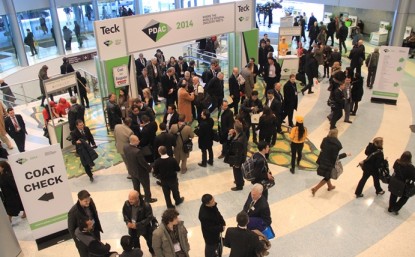
For those of you attending this year’s PDAC in Toronto, the world’s largest mining convention, this is your invitation to our CEO Summit on Saturday Feb. 28th at the Hilton Hotel – that’s the day before the PDAC begins.
Click here for event details and here to register now.
This exclusive event is put on by three leading mining and energy newsletter writers, Keith Schaefer of the Oil and Gas Investment Bulletin, Eric Coffin of Hard Rock Advisory, and me.
The Summit is everything the PDAC isn’t. Rather than trying to put 25,000 people in a room we’ve invited 15 of our favorite mining and energy CEOs to present and meet with a few hundred of our subscribers in an intimate setting that’s for serious investors only.
Here are three reasons you should register now:
- Grow your wealth. These are hand picked companies presenting chosen for their immediate investment merit. No brokerage research, SEDAR filing of press release will ever tell you as much as a CEOs body language. Additionally, get all your questions answered directly from the CEOs themselves during breakout sessions.
- Grow your knowledge. The newsletter writers and CEOs themselves will share their industry and regional expertise. The knowledge will allow you to make better investment decisions.
- Grow your network. You’ll be in excellent company at the CEO Summit. Many of the most influential entrepreneurs and investors in our network, from investment bankers, fund managers, and analysts, to CEOs and technical professionals, will be on hand to take in the presentations and catch up over coffee and lunch. Building networks of like-minded investors is absolutely critical to becoming a successful investor (in addition to meeting the CEO’s in person).
Presenting companies include cash cow Nevsun Resources, high grade Colombian gold juggernaut Continental Gold, sister explorer Cordoba Minerals, the latest uranium discoverer NexGen Energy, and arguably the most exciting diamond junior, North Arrow Minerals. There couldn’t be a better time to meet the CEO’s of these companies, as current markets are resulting in profound change in the sector.
“Meet our hand-picked success stories for 2015 in person—and give yourself some high conviction stocks for the rest of the year.” Keith Schaefer commented.
“These are the companies positioned to make the most of a new bull market. Do yourself a favor and be there to meet the CEOs and hear their stories.” Eric Coffin added.
Personally, I’m excited about the chance to catch up with some of the CEO.ca subscribers who make all of this worthwhile. I know I’ll learn about investment opportunities, meet some in the know people, and potentially find the next big winner.
Register for the Feb 28, 2015 Toronto Subscriber Summit now (click here to do so).
Seating is limited so don’t wait.
Sincerely,
Tommy Humphreys
Founder,
CEO.ca
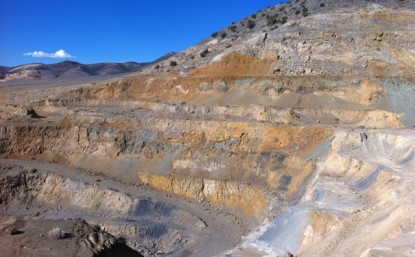
The following interview of Pershing Gold’s (PGLC) CEO Steve Alfers was conducted by phone and email from February 2-4. I, Peter Epstein have no prior or existing relationship with Pershing Gold.
Q. Please expand upon the significance of Pershing’s February 4th press release regarding new high-grade drill results.
A. We reported an intercept over 39.0 ft./11.9 meters of 10.12 grams per tonne (gpt) gold (Au)/0.295 ounces per ton (opt) Au including an interval over 4.7 feet/1.4 meters of 76.8 gpt Au/2.24 opt Au, by far our highest grade gold intercept at the Relief Canyon project. In the context of our entire 2014 drilling program this core hold RC15-264 is an exclamation point on our 135-hole drill program in the North Target Area. Throughout the 2014 drilling program we have consistently reported a pattern of thick intercepts with gold grades two to five times higher than the average grade of the existing gold resource at Relief Canyon. RC15-264 includes an intercept at a grade an order of magnitude higher than the average grade of the resource. As such, it is a game changer. These results demonstrate once again that our deposit appears to be growing in size and in grade. These results will be included in our upcoming resource report. They should significantly enhance the economics of the project, potentially making Pershing Gold the premier emerging gold producer in Nevada.
Q. There has been a lot of news flow lately, please give readers a description of Pershing Gold.
A. Simply stated, Pershing Gold Corporation is an emerging Nevada gold producer uniquely positioned to create shareholder value by the reopening of the Relief Canyon Mine, as soon as October of this year. Pershing Gold’s strategy to create shareholder value has four elements. First, confirm, expand and upgrade the gold resource. Second, re-commission the existing heap-leach processing facility at Relief Canyon to fast track the company to production. Third, explore strategically located 25,000-acre contiguous land package around Relief Canyon. Fourth, create value through strategic acquisitions. We expect to be the next gold mine to reach production in mining friendly Nevada but we don’t expect to stop there. Pershing Gold is a growth story in the gold mining business.
Q. If Pershing Gold commences production in the fourth quarter, how long might it take to ramp up to nameplate capacity?
A. How long it takes us to obtain nameplate capacity turns on a couple of things, most notably, how quickly we can get to an optimal mine rate. That turns on how quickly we receive amendments to permits to mine the expansion areas outside the existing pits. As Relief Canyon continues to get bigger and better, there will be opportunities to grow production. As our talented team makes new discoveries on our 25,000 acre land package, some of those discoveries could also become mines. However, we are a few years away from bringing on any new mines after Relief Canyon. Still it’s exciting to have such meaningful exploration upside.
Q. Please explain the importance of your recent news release regarding the purchase from Newmont. [Please see PR here]
A. There are multiple important points with regard to this landmark acquisition. First, we immediately unlock value by getting full control of the ounces known to exist in the acquired lands. Second, we now have complete control of new discoveries. Third, we acquired considerable surface rights we need to expand our mine dumps and processing facility (which will become very important as we grow). Fourth, we continue to develop our longer-term relationship with Newmont, which is stronger and better now. We amended an agreement where we are still collaborating with Newmont, by renewing our exploration agreement with them. Newmont is a neighbor elsewhere in the district, so it’s good to enhance our relationship with them.
Q. When might you have a new resource report out? Will it incorporate all the drill holes done to date?
A. The new resource report will be out later this quarter, or early Q2. It will include the results of our 2014 drill campaign all the way through January of this year. That upgraded resource will be plugged into our in house scoping study and our geologic model. At that stage we should be ready to commission a third-party Preliminary Economic Assessment, “PEA.”
Q. Do you expect to commission a third-party PEA? If so, when might that be completed?
A. We are just finishing up our 2014 drill program now. Once we get the results of all the holes drilled, we will get them assayed and then work on a new resource report. Once that’s done we will submit all the data required for a third-party PEA to be done. We expect that a PEA could be delivered in the second quarter of this year.
Q. There have been research reports written on Pershing Gold. Do you expect additional sell-side firms to pick up coverage?
A. We periodically have conversations with sell-side firms, but of course we can’t name names. Getting the company up-listed in the near future will better allow additional sell-side shops and, importantly, more institutions to own Pershing’s stock. We have applications pending with exchanges, it’s in their hands. We expect an up-listing over the next few months, perhaps sooner.
Q. Moving south on your property is Pershing Pass, has there been any exploration done there?
A. We’ve been continuing to develop targets down there. We are continuing with systematic mapping of targets. We are conducting early stage soil sampling & geophysics, but we’ve not drilled there yet. Moving closer to our northern boundary with Coeur Mining is Buffalo Mountain. We have drilled there, and there are some holes there that are encouraging. But, exploration there is at an early stage.
Q. Are you finding more silver the closer you get to Coeur Mining?
A. Yes, some very high silver grades.
Q. How much remaining capital might be required to get Pershing’s Relief Canyon into production later this year?
A. We haven’t yet made the decision on the timing of the reopening of the mine, so I can’t give you a firm number right now. However, we have enough cash on hand to fund our planned and Board approved activities through 2015.
Q. Pershing currently has zero debt. Would you consider utilizing $5-$10 million of debt capital?
A. We will consider capital alternatives including royalties, equity and debt as we move closer to production. With a debt-free balance sheet we believe the options available to us should be fairly attractive.
Q. Trading volume in your stock has picked up and was already strong compared to peers, are any institutions getting involved?
A. Our trading volume is routinely higher than many of our peers. That’s been the case not just recently, but for quite some time. While we want to get more institutions into our shareholder base, there are already some institutional investors involved. In addition, our largest shareholder continues to demonstrate his conviction by making open market purchases.
Q. Your January, 2015 Corporate Presentation mentions tuck-in acquisitions. Can you elaborate on what you might be looking at?
A. Yes, given the devastation of the junior gold market, we are open to opportunities. Remember, Relief Canyon itself was acquired in a distressed sale. We are looking for gold assets in North America where we can leverage operating synergies with our processing facilities and our talented team. Having said that, our focus is on open-pit, heap-leachable projects in Nevada.
Q. Are there any misconceptions about Pershing Gold that you would like to address?
A. A key point is that Relief Canyon is a past-producing mine, we are no longer an exploration play, we are an advanced developer with a new open-pit mine and a fully owned and permitted processing facility. We are permitted to start production from within the main disturbance area (the past producing open pits). Relief Canyon was discovered in 1970’s, but last drilled in 1989. Over those years no one could develop a sizable project because the land package around the mine was not consolidated. Within three months of Pershing Gold taking over, we struck deals with nearby landholders including Newmont and we were off to the races.
More to your question, we’ve dispelled many of the unknowns and greatly de-risked our company. For example, we demonstrated that we have established a Carlin-style deposit. These types of projects often have size to them. We’ve proven that the deposit is able to grow, both in grade and in size. We’ve done extensive metallurgy work and have shown that our ore is very amenable to heap leaching. Our recoveries are higher than some nearby mines. Our stated average grade of the deposit is quite attractive when considering the other essential components of a viable mine, including factors such as operating cost, low strip ratio, modest capital needs, recoveries, access to a processing facility and timing of initial production. Our recent press release of February 4, 2015 reports really stunning new high grade results. They surely show that Relief Canyon is getting bigger, better and, above all, higher grade.
Q. Why should investors buy shares of Pershing Gold vs. the multitude of peer gold companies in Nevada?
A. Pershing is an emerging producer for one thing, largely de-risked. We are much more than an exploration company, but we still maintain substantial exploration upside. We feel that emerging producers is where the leverage is, where the lift is. From development to production we are in the sweet spot of the market and located in one of the most sought after jurisdictions in the world. We have a strong management team and two significant and loyal financial backers. Our asset package separates us from the rest of the pack. We don’t need a great deal of incremental capital to get into production. We have a low-cost, open-pit, heap-leach project, good grade, low remaining cap-ex and zero debt. If all goes well, we could be producing soon at a substantial run-rate at a low all-in sustaining cost.
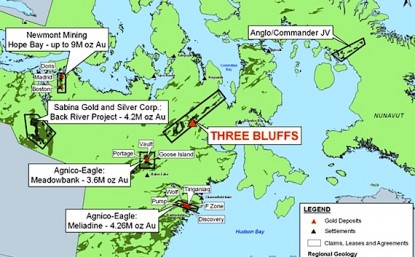
Big news out of the junior mining sector today as Auryn Resources (AUG:TSXV) and North Country Gold (NCG:TSXV) have reached a joint venture agreement on the Committee Bay project in Nunavut, Canada.
The market likes the deal so far sending Auryn shares 16% higher to $1.29 and North Country up 114% to $0.075.
The deal appears to be a win/win for both companies. Auryn was a cash rich shell well funded with ~$8 million that was looking to acquire/option an asset for the last several months. North Country was in a tough financial position with only $78,468 in cash as of November 30th but has an exciting 300 km prospective land position.
The team at Auryn led by Shawn Wallace and Ivan Bebek are coming off the successful recent sale of explorer Cayden Resources to Agnico-Eagle last fall. Cayden was the second transaction after Keegan (now Asanko) for the young guns Mr. Bebek and Mr. Wallace. These two men have arguably the best track record in the Canadian mining space for their age.
The deal involves:
- Auryn has the option to spend $6 million for a 51% interest to earn a 51% interest in the Committee Bay project.
- $500,000 is guaranteed once the definitive option agreement is signed.
- A technical team will be formed to jointly plan and oversee exploration programs.
- Auryn will have the final discretion over exploration issues and will become the project operator.
- Once the agreement is signed Auryn will purchase 10 million North Country shares at 5 cents ($500,000) as part of a non brokered private placement
Shawn Wallace, President and CEO of Auryn stated, “We are very pleased to have successfully formed a working relationship with North Country. The opportunity to leverage the large amount of quality exploration work completed to date in order to exploit the exploration potential of this highly productive, prolific high grade gold district presents an excellent opportunity for value creation that will benefit both companies’ shareholders. Entering into this agreement also signifies Auryn’s first step at realizing its aspirations of becoming a formidable high grade gold exploration and development company in the Americas.”
Once the deal closes the two partners will together be able to explore the 300km land position that is historically under explored and has over 50 gold occurrences and a historical gold deposit at Three Bluffs. The Three Bluffs deposi is a high grade deposit with an NI-43101 resource of 683,000 ounces @4.91 g/t of indicated gold and 965,000 inferred ounces @ 5.43 g/t gold.
CEO.ca reached out to Auryn and they commented that the deal had everything they wanted in an joint venture.
- A large land position which is under explored (district scale exploration upside).
- A high grade asset.
- A mining friendly jurisdiction with majors in the area.
They also mentioned that North Country has already spent 20 years and $80 million on the project. North Country also owns 4 drills plus millions in equipment and infrastructure already in place.
The three points above mentioned to me by Auryn are exactly the same as the features they had in Cayden which lead to a $205 million dollar deal last fall.
I will definitely be following the story at Auryn and North Country and will have both companies on my watchlist.
Read: Auryn Resources and North Country Gold to jointly explore the high-grade Committee Bay Gold Belt
This is not investment advice.All facts are to be checked and verified by reader. As always please do your own due diligence.
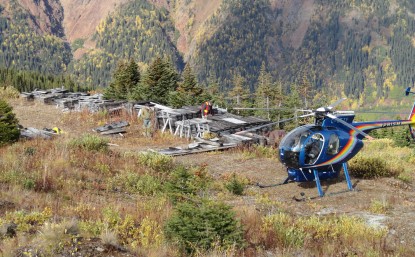
Skeena Resources (SKE.V) (SKREF) is one of a number junior gold companies in Canada, but one with a secret weapon.
Its Chairman, Ron Netolitzky, happens to be one of the foremost geologists in the world, especially so in the Golden Triangle of northwest British Columbia. Mr. Netolitzky is one of the primary developers behind the Snip Mine and Eskay Creek mines. For these achievements, among many others, Mr. Netolitzky received the Prospector of the Year award from the PDAC, and Developer of the Year award from the BC & Yukon Chamber of Mines. Add to the list Netolitzky’s induction into the Canadian Mining Hall of Fame just a few weeks ago.
Please see this video clip describing Netolitzky’s prolific achievements.
In addition, on January 11, 2015, the Northern Miner profiled Mr. Netolitzky in this two page article. Not only is Mr. Netolitzky the Chairman, but he’s also the second largest shareholder, having invested $2 million of hard cash over the years. Make no mistake, with Netolitzky as Chairman, Skeena Resources is as well placed to find additional resources suitable for an economically viable mine as any junior in Canada.
Skeena Resources is lucky to have a strong team around Netolitzky, including Rupert Allan B. Sc., P. Geol., Vice-President, Exploration & Director, Walter Coles, Jr., President & CEO, Wendy T. Chan, B. Sc., MBA and Michael Cathro, M. Sc.,P. Geo. Skeena therefore has not one, but three very accomplished geologists on board, virtually unheard of for a company of this size.
The Company’s Spectrum project already has an historical, non NI 43-101 compliant, resource of high grade (12.3g/t) material containing an estimated 243,600 ounces of gold. In addition, Skeena has an extensive and valuable database of historic data including geological mapping, geochemical sampling, trenching and more than 100 diamond drill holes (>12,000 m). With a highly experienced team and armed with ample historical data, Skeena hopes to delineate 1 million ounces of NI 43-101 compliant Indicated & Inferred gold resources within 12 months and subsequently up to 2-3 million ounces. A key takeaway is the results of the company’s first 9 drill holes, drilled in 2014, which are discussed below.
The following interview of Mr. Netolitzky took place by phone and email between January 30th and February 2nd. I, Peter Epstein, interviewed Mr. Netolitzky and I own shares in the company that I paid for myself. I have no prior or existing business relationship with Skeena or any company named in this interview. Skeena is a highly speculative investment opportunity. Readers should conduct their own due diligence and consult with their own investment advisors.
Mr. Netolitzky, thank you for taking the time with me for this interview, can we please start with a description of Skeena Resources?
Skeena Resources is most focused on advancing its Spectrum gold & copper exploration property located in the, “Golden Triangle” in northwest British Columbia. Our 3,580 hectare property is approximately 37 km west of Imperial Metals’ Red Chris mine and 16 km west-northwest of the NGEx/Teck GJ deposit.
The Spectrum resource appears to be a high-grade deposit that has extensive historical data, including geological mapping, geochemical sampling, trenching, more than 100 diamond drill holes (>12,000 m), and one small underground adit (278m of drift and crosscuts). The majority of this valuable data dates back to Columbia Gold Mines work from 1990-1992. At the time, an ‘inferred’ non NI 43-101 compliant resource of 614,000 tonnes grading 12.3 g/t Au containing 243,600 oz. was estimated to a projected depth of approximately 150 meters. Given our recent successful drill campaign, and ample historical data, we hope to establish a NI 43-101 resource of 1 million ounces of gold within the next 12 months.
Skeena has put out two press releases regarding drill results on a total of 9 holes, were the results as good as hoped for?
We are very pleased with the results of our 9 hole drill campaign last year. Highlights can be found in the two press releases, first 5 holes last 4 holes
[NOTE: For convenience, highlights from the two press releases are reprinted here] 23.84 g/t over 6.5 m, including 40.43 g/t over 3.5 m in 14-SP-003; 10.63 g/t over 27.0 m, including 66.00 g/t over 2.0 m and 20.4 g/t over 2.0 m, 9.2 g/t over 2.0 m; 8.0 g/t over 2.0 m; and 22.7 g/t over 2.0 m in 14-SP-004; 18.60 g/t over 2.0 m, 3.19 g/t over 4.0 m, 7.32 g/t over 2.0 m, and 6.88 g/t over 2.0 m in 14-SP-005; 43.80 g/t over 2.0 m in 14-SP-006; 9.50 g/t over 2.0m in 14-SP-007; 4.58 g/t over 9.0 m in 14-SP-008; 13.70 g/t over 4.0 m and 254.50 g/t over 2.0 m in hole 14-SP-009. Importantly, this last intercept represents the deepest intersection of significant mineralization obtained to date (from 285 m to 287 m) and the deposit remains open on strike and at depth. Intercepts averaged 50 m beneath historic intersections, and exhibited excellent vertical continuity, suggesting high-grade mineralization may extend to significant depths.
Why do you think that you might be successful in finding an economic deposit in a basin that’s been actively explored for decades?
That’s an excellent question. The simple answer is that our 3,580 hectare property hasn’t been systematically explored, (except directly on the Central Zone), especially using modern techniques. The property was inactive for 22 years due to government issued right-of way restrictions, recently resolved, allowing the project to move forward. Further, the vendor of the property to Skeena was difficult to deal with. I spent years trying to cut a deal with him before he relented. This opportunity is in my sweet spot, a high-grade zone(s) occurring within a broader halo of low-grade porphyry-style Au-Cu mineralization about 50 m wide and about 600 m strike length. The kind of high-grade, low cap-ex prospect that, if it reaches 1.0 million ounces with good continuity, will very likely become a mine.
Please tell us about the East Creek Zone and its potential importance?
The East Creek Zone, some 1.5 kilometers further to the north of the Central Zone, is a north-trending, 5 m wide silicified zone with gold, pyrite, arsenopyrite, chalcopyrite and sphalerite, traced at surface for a 600 m strike length. A trench sample yielded 58.4 g/t Au over 2.6 m. The East Creek Zone has only been tested with 3 drill holes to date. Two of those drill holes yielded 1 to 2 g/t over less than 2 m, while the third hole yielded 34.45 g/t over 2.6 m. Apart from a single drill hole to the north of the Central Zone Fault, most of the intervening 1.5 km section between the Central and East Creek Zones has not been drill tested and provides an attractive exploration target. If we find continuity between the Central Zone and the East Creek Zone, we could have a very significant deposit with multiple millions of ounces.
Can we get a snapshot of your capital structure? Is there any debt?
As of February 2nd, Skeena has 163 million shares outstanding [89,102,207 shares are subject to Exchange escrow, 360,000 options are escrowed, and 180,000 warrants are escrowed]. Additionally, 80,000,000 of the escrowed shares are further subject to a Pooling Agreement, managed by Mr. Netolitzky, Chairman of Skeena], plus approximate 42 million warrants at $0.10 (essentially at-the-money) and 16 million at-the-money $0.10 stock options. Fully diluted, including at-the-money shares = 221 million. Currently we have no debt. We will probably raise $3-$4 million for the 2015 drilling and for general corporate purposes.
After raising new capital, how long will that fund the company for?
This important capital raise will largely fund us for 2015 and into 2016. Interest in the project has been high. We raised $3 million in Q4 of 2014, which in this particularly inhospitable financing environment is a strong vote of confidence in the technical merit of the Spectrum project and the strong management team. Frankly, the drill results from our first 9 holes were better than we expected. As such, we are optimistic that we will continue to be able to raise capital to advance this very rare high grade gold project. Nevertheless, we plan on maintaining at least $1.0 million of cash on our balance sheet to withstand market uncertainties.
Do you have contact with any First Nations groups, if so, how are your relations with them?
An Archaeological Impact Assessment was undertaken on the in September, 2012 in conjunction with Rescan and a JV company of the Tahltan First Nation, without any significant archaeological issues being uncovered. Skeena looks forward to working with the Tahltan First Nation and other local stakeholders in order to advance a profitable, financially stable, project that the Company hopes will create value for all stakeholders and lasting economic and social benefits for the region.
Please describe in what ways Skeena’s property is like and is different from other Golden Triangle operating mines and/or exploration projects.
The property contains more than 10 different showings of high-grade sulphide-gold mineralization, spatially associated with steeply-dipping fracture zones contained within a broad area. This is the same type of geological setting as many of the major copper-gold deposits in the Golden Triangle area of northwest British Columbia except that Spectrum has demonstrated much higher gold grades.
Skeena’s corporate presentation says that your property is near critical infrastructure and resources, please explain.
First and foremost we have excellent access to roads [paved Highway No. 37] and power [the new hydro line into the Red Chris Mine], each built or upgraded in the past decade. Furthermore, an experienced labor force is available in the region. The port of Stewart is also available to us. We’re not shipping a bulk commodity like coal, so the overall logistics aren’t particularly onerous.
What’s Skeena’s exit plan, will you go into production or advance the Spectrum property enough to try to sell it?
We strongly believe that a great deal of the upside in a junior exploration company comes from discoveries, followed by resource reports, followed by infill drilling to better delineate the resource, followed by building a detailed model of what might be there, followed by more drilling and modeling to compile a Preliminary Economic Assessment, “PEA.” At that stage, my experience has been that suitors start to take a serious look sometime after 1.0 million ounces have been defined in a NI-43-101 compliant resource and/or after the subsequent PEA. If Skeena has what I think it does, namely high-grade gold with relatively low cap-ex and operating costs, then it will be an attractive takeover target.
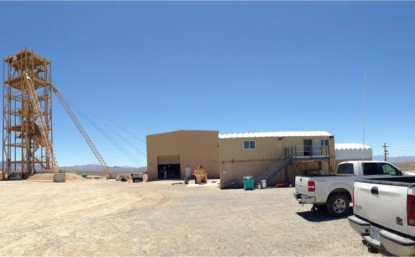
The following interview is with the CEO, President and Founder of Nevada Copper, Giulio T. Bonifacio. This interview was conducted in the last week of January, 2015. I, Peter Epstein, have no prior or existing relationship with any company mentioned below.
Q. Can you describe Nevada Copper for those not familiar with the story?
A. Nevada Copper (NCU.v) (NEVDF) was formed in 2005 to acquire and advance the Pumpkin Hollow copper project near Yerington Nevada. Yerington has a mining history with the former Anaconda open pit mine operating successfully from the 1950’s to 1980’s. The Pumpkin Hollow copper project encompasses several copper deposits all in close proximity. The East and E2 deposits are high grade and, being deeper, are being advanced for underground exploitation. Two other deposits, the North and South, are suitable for open pit mining.
Q. How long has Nevada Copper been working on Stage 1 of Pumpkin Hollow? How much has been invested to date?
A. As mentioned above, Nevada Copper has been working on advancing the project for about 9 years. Nevada Copper, in 2012, recognized that the project has the natural ability to be developed in two stages because the high grade underground deposits could be permitted much more quickly with State permits (no Federal permits needed, as the Stage 1 project is entirely within private lands) – and at a much lower initial capital cost than would be required for a large open pit operation. So a stand-alone underground operation, designated as “Stage 1”, would be development of the East and E2 deposits.
Nevada Copper has invested over $180 million in Pumpkin Hollow since formation in 2005. About $69 million of that has been directed at Stage 1 development since 2012 including hoist, head-frame, shaft sinking infrastructure, and engineering.
Q. Please explain the importance of the December 12th and December 19th press releases about the transfer of BLM property to the city of Yerington, Nevada?
A. December 19th 2014 is really the only date to remember. It is the date that President Obama signed into law a bill that contained language that directed the BLM within 180 days, to sell at fair market value approximately 10,400 acres of Federal land surrounding Pumpkin Hollow to the City of Yerington. (The date to underline is June 17, 2015 – 180 days from December 19, 2014). We expect the acquisition price to be about $2 million based on our recent independent valuation.
Our agreement with the City of Yerington is that we fund the acquisition for the city and, once acquired, they would deed almost all of this acquired property to Nevada Copper except for a small portion (not affecting Pumpkin Hollow) retained for “public event” purposes. The land deeded to Nevada Copper essentially converts this property into private ownership of both the surface and mineral rights by Nevada Copper – note we already had the mineral rights. The importance of this is that with no Federal land now involved we can quickly permit the larger Stage 2 open pit development – much like we were able to for Stage 1 – by June 2015. In short we expect to be fully permitted on both Stage 1 and Stage 2 by June 2015 which is a significant milestone and re-rating event.
Q. Please describe your capital structure including drawn debt and cash, will you require an equity raise anytime soon?
A. We currently have 80.5 million shares outstanding, $36 million in cash, $90 million drawn against the $200 million Red Kite facility and a $15 million draw against a $20 million bridge facility. With a substantial cash position, we are not pressed to do an equity raise, but would consider doing so sometime later in 2015.
Q. Can you describe the off-take agreement that comes along with the new secured credit facility?
A. Red Kite debt facilities typically include a copper offtake component and ours is no different. It is notable that the Red Kite offtake arrangement applies only to the Stage 1 development – not the larger Stage 2. Under the new facility Red Kite is entitled to buy a proportion of the remaining available Stage 1 concentrate production – pro-rata to loan draws. With 25.5% of offtake already committed under the previous facility, under the new Red Kite facility it has rights to buy 45% ($90/$200) of the remaining 74.5% of the Stage 1 offtake available. At this point a total of 59% of offtake has been allocated on the Eastern deposits representing only 12% of the total project reserves. Under Red Kite’s offtake arrangements, Nevada Copper pays a small premium on top of annual “benchmark” TC/RC’s. Metal pay-factors are industry standard.
Q. Pro forma for the Nevada Copper’s new $200 million secured loan facility, how much additional capital do you believe is needed to get stage 1 into production?
A. Stage 1 name plate initial cap-ex was $329M including $25M of contingency. We have spent approx. $70 million leaving $259M. This leaves a shortfall of approximately $140 million which will be raised by way of equity, but is not required based on the current facility until later in 2015. This is also a key benefit of this debt facility. We are also exploring several financing alternatives which will likely reduce the equity requirement. In short we have been very disciplined with our share structure and there is no reason to assume that this will change.
Q. If the copper price keeps falling, is there a level at which you would slow development of Stage 1?
A. We, of course, monitor current copper prices, but our focus is on copper markets in 2016 and beyond. We have already slowed Stage 1 engineering and procurement to match shaft sinking progress. As a significant de-risking event, we elected to continue shaft sinking which is now close to 90% complete. Of course with the land bill passed and the open pit development permits expected in June 2015, we can now consider whether we use the underground as a high grade feed supplement to the open pit ore, feeding a single large concentrator. The smaller Stage 1 mill would not be required. No decision has been taken yet.
Q. How important are your gold and silver credits to the prospective all-in operating costs in Stage 1?
A. Gold and silver are important revenue credits in our copper concentrates accounting for 5-10% of revenues.
Q. How close is Nevada Copper to finishing digging its shaft for Stage 1? Are you encountering any budget or timing issues?
A. The shaft is at 1,761 feet, about 92% to the main 1,900 foot haulage level and is expected to reach that level next month.
In dealing with sometimes variable, and unexpected, ground conditions, shaft sinking commonly presents challenges and these can add to costs. Our case is no different, but the few problem areas were not unexpected and were overcome in a professional manner by Cementation, our shaft contractor. These challenges are now behind us – a major milestone is within sight.
Q. What should prospective investors expect to see in your mid-year updated Phase 2 open pit feasibility study?
A. Indications from preliminary engineering work is the updated Stage 2 will see an improved early copper production profile which in part is based on the additional 10,000 meters of drilling which did not get captured in the last updated reserve. Cap-ex will be updated but is not expected to change materially. All mining costs will be reviewed and updated including lowered diesel prices.
The results of the drilling noted above further supports additional drilling in 2015 in view of the open extend of the open pit deposits.
Q. GMP describes the combined Stage 1 & 2 projects as a, “world class project.” How does the expected overall size of the project compare to global peers?
A. Pumpkin Hollow projected Stage 1 & 2 combined copper production is approximately 250+ Mlbs annually with first production 2016-17.
This is certainly the only new large scale U.S. copper project projected to come online in this time frame while also being completely permitted by June, 2015 which is contrast to other projects in the U.S. with permitting timelines that have not been achieved.
In short to have a fully permitted project of size in Nevada, located in an ideal jurisdiction, puts Nevada Copper in a very enviable positon as it relates to the growth profile in the short term.
Q. How would you describe the pipeline of copper-focused projects around the world. Do you envision a number of new projects coming online before the end of the decade?
A. Without doubt, additional copper projects now in the pipeline will come into production. However, one should note that several large scale copper projects are required each year simply to match a copper demand that is relentlessly increasing– albeit at a somewhat slower pace than in past years. And these new copper projects entail inevitably higher capital costs and lower grades, with many located in politically risky parts of the world with high infrastructure costs. Pumpkin Hollow is a very low risk jurisdiction with labor and infrastructure available close at hand.
Q. Some analysts consider Nevada Copper to be a prime takeout candidate. What are your thoughts?
A. Our primary focus is to continue to add value and with the current strong shareholder support this is only possible at levels that are multiples of the current share price. The current shareholder base has an appreciation of the context of the market, which has not currently valued Nevada Copper at a value that would be considered. As our valuation improves, and it will due to location, size, low risk profile and full permits, a takeout is entirely possible.
Q. Why should investors buy shares of Nevada Copper? How does the investment opportunity compare in terms of valuation to peers and recent M&A activity?
A. Low risk, fully permitted (June 2015) ; large scale copper project in the U.S. Southwest; close to infrastructure and abundant local support. See below re: copper valuation comparables.
Q. Are there any misconceptions about Nevada Copper that you would like to address?
A. A true lack of understanding that with the passage of the land bill, we will be fully permitted in the short term and not a complete understanding that Nevada Copper is in possession of a project of significant size with further upside in one of the best mining jurisdictions worldwide.
As we bridge this gap, which will be achieved in the short term with full permits and an updated feasibility study on the larger operation, it is likely in our view that our current valuation of 2.0 cents per Reserve pound will increase. By comparison, there has been much consolidation in the copper sector for which the values garnered were in the plus 10 -15 cents range per proven and probable reserve.

Those who’ve been following the events of the past two months know that Meson Capital LLC, as represented by Ryan Morris, and UK-based Nightscape Capital LLP have been vying to unseat Aberdeen’s current board with their own replacements.
Meson and Nightscape’s efforts had forced Aberdeen to call a special shareholders meeting, which was planned for tomorrow, February 3rd. The meeting would determine once and for all whether Ryan Morris and his nominees would gain control over Aberdeen International, or whether Aberdeen’s current board would remain in power.
As it turns out however, Meson Capital and Nightscape were unable to generate enough votes among Aberdeen’s shareholders. As a result, Meson Capital and Nightscape withdrew their request today for the special shareholder meeting and, along with that, withdrew their court application against Aberdeen and any affiliated parties.
No company enjoys a forced proxy battle. But, if anything, Meson Capital’s takeover attempt gave Aberdeen management an opportunity to refocus its relationship with its shareholders. It also reaffirmed the support Aberdeen management has with its shareholders.
Issuing a press release today after the shareholder meeting cancellation, Aberdeen commented that “… the results of [the proxy vote] demonstrated significant support for the current board and its plan to create long-term shareholder value in the midst of challenging market conditions.”
The result of the proxy vote was not only a positive reinforcement for Aberdeen management, it also was a vote of confidence for Stan Bharti, a man who found his name unfairly dragged through the mud during the proxy battle.
Stan Bharti is chairman of Aberdeen International and also happens to be responsible for successfully driving a number of significant mining projects to market during his career, including Consolidated Thompson Iron Mines and Desert Sun Mining.
Over the past month, Stan Bharti found himself personally the target of criticism coming from the side of the dissidents, Meson Capital and Nightscape Capital.
However, in calling off the shareholder meeting, Meson and Nightscape also retracted the numerous negative claims they had made against Bharti and any judgments that called into question Bharti’s management integrity or his ability to independently and prudently lead Aberdeen’s board over the long-term.
As Aberdeen’s press release details, in discussing Aberdeen’s financial position and the company’s long-term plans, Ryan Morris admitted that he was wrong in casting doubt over Bharti’s leadership of the company:
At the outset of this contest I expressed concerns that Mr. Bharti was not acting in the best interests of the companies in which Forbes & Manhattan has an interest. Having initiated this process and seeing that the majority of the shareholders voted in his favour, I now realize that I was wrong.
Ending his retraction, Morris then went on to offer a formal apology to Bharti, saying: “I unreservedly apologize for the prior comments I have made that called into question Mr. Bharti’s integrity.’
Many shareholders will breathe a sigh of relief in hearing that this chapter of Aberdeen’s company history has come to a close. As for Stan Bharti and Aberdeen’s management, they are taking a positive, constructive view of the past month and are looking forward to being able to execute on their long-term plans for the company. With the resource market slowly recovering from a sour 2014, this may be the perfect opportunity to do that.

It was in 1896 when prospectors stumbled across large quantities of gold in one of the tributaries of the Yukon’s Klondike River. Word of this discovery spread like wildfire. And in no time at all prospectors from far and wide set course to get a piece of the action. The aptly named Klondike Gold Rush ended up being one of legend!
Provocatively this legend was not entirely one of smashing success and untold riches though. Yes, there were some who cashed in, but it was ultimately one of endless frustration and failure. Gold fever ended up blinding folks to the reality of the Yukon’s harsh climate and challenging geography. And most of those who journeyed there were ill-equipped to deal with it.
Amazingly of the 100k+ prospectors who set course to score Klondike gold, less than 40k even made it to the promised land. Navigating the steep mountainous terrain and dealing with the intense cold and snow proved just too much. Many died, and many turned back. And sadly most of those who did make it struggled mightily to find gold in the Klondike’s hard-to-dig permafrost.
It was no surprise then that there was a mass exodus when gold was discovered in nearby Nome, Alaska in 1899 where the environment was much milder and it was easier to extract. The Klondike Gold Rush had ended nearly just as soon as it had begun. And by the turn of the century the boom towns had gone bust.
This swift departure was followed by a century or so where the Yukon experienced very little gold exploration and development relative to the rest of Canada. And this is reflected by the fact that this territory only produces about 2% of the country’s gold, less than 100k ounces per year.
The 21st-century gold bull market has however relit a fire under the Yukon’s gold allure. Considering the amount of gold the prospectors of yore were finding in streams and outcrops, clearly there’s vast potential to discover the deeper source deposits. And since the modern mining companies are obviously not as vulnerable to the Yukon’s logistical challenges, they’ve gotten busy working this underexplored region targeting major discoveries. And perhaps none is better than the one contained within Kaminak Gold’s Coffee project.
Coffee is located about 130km south of historic mining town Dawson City. And though access is limited to air and barge, a physiography that includes gently rounded hills that are only partially covered in trees makes Coffee’s terrain comparatively mild to the rest of the territory. This area did see a small amount of placer activity around the time of the Klondike Gold Rush, but it didn’t see its first meaningful hard-rock exploration until about a century later.
Kaminak Gold got its hands on the project in 2009. And it set out to follow up on some recent promising early-stage exploration work that showed great gold potential. In its first pass Kaminak identified several gold-in-soil anomalies. And its maiden drilling program the following year resulted in some awesome high-grade discoveries.
The Supremo, Double Double, and Latte zones really stood out. And further exploration showed them to be fantastic near-surface gold deposits amenable to bulk-tonnage mining. Kaminak thus released the drilling hounds in order to prove up and expand the resources. And each subsequent drilling season has stoked more and more excitement for Coffee’s future.
Interestingly drilling seasons in the Yukon run from early spring to late autumn, which differs from most other Canadian gold districts. Out east where it’s flatter winter can actually be a good time to drill, when the mud and lakes are frozen over. But in the Yukon where the mountains are steep, the snow is plentiful, and all-weather roads are few and far between, winter is when surface operations are typically shut down.
By the end of the 2014 season Kaminak’s geological baristas had drilled over 200k meters in 1000+ holes. And this has fed a series of resource estimates, the latest showing Coffee to contain a whopping 4.2m ounces of gold. And most exciting about this resource is that a core section (2.6m ounces) is classified as oxide mineralization, which makes for much cheaper mine development and extraction.
With Kaminak gaining more confidence in Coffee’s resources, it ran a preliminary economic assessment to give it an idea of its economic potential. And the results, which were announced in June 2014, were staggering.
Coffee was drawn up as a conventional open-pit heap-leach operation. The ore, of which about three quarters would come from the flagship Supremo deposit, would be thrice-crushed and processed at an onsite Adsorption-Desorption-Recovery carbon plant at a rate of nearly 14k metric tons per day. With the core resource grading an average of 1.2 g/t and gold recovery averaging 88%, Coffee would produce 167k ounces per year over an 11-year mine life.
The PEA estimated Coffee’s preproduction capex at only $305m. Not only does this include onsite infrastructure such as the processing plant and mining equipment, it includes support infrastructure like a 250km all-season access road to the Klondike Highway.
Most attractive about this prospective mine though is its projected operating costs. Over the life of the mine, all-in sustaining costs are estimated at only $688/ounce. This is easily in the lower quartile of industry average. And at $1250 gold it will allow for a payback period of only two years along with an impressive after-tax internal rate of return of 26%.
Even given the recent lower prices, it really was a no-brainer to move forward with advancing Coffee towards development. And Kaminak is full steam ahead as it performs comprehensive environmental baseline studies and infill drilling. The environmental studies will feed the ever-critical Environmental Impact Statement in advance of permitting. And the drilling will feed a feasibility study that will prove up Coffee’s gold to the reserve categories.
Despite the crummy market conditions, Kaminak Gold didn’t have any problem raising capital to fund Coffee’s advancement. Within a month of announcing the PEA results, it succeeded in raising C$25m via the sales of shares. And interestingly a big chunk of this was strategic investments from industry magnate Ross Beaty and a trust endowed by the Lundin family. It’s always a good sign when the power players take notice!
Kaminak is expected to resume drilling and related field programs in February. And in addition to infill drilling it will perform condemnation, geotechnical, and hydrological drilling. KAM’s aggressive 2015 program is expected to provide all the data necessary to complete the feasibility study. And it is targeting the end of 2015 or early 2016 to announce the results.
If the results are in line with the PEA, this project ought to quickly transition to the development stage. And assuming the successful procurement of permitting and financing, the Yukon will soon have its newest and largest gold mine. This transition will make for an exciting next couple years. And investors can really get in for cheap given KAM’s deeply discounted stock-price levels.
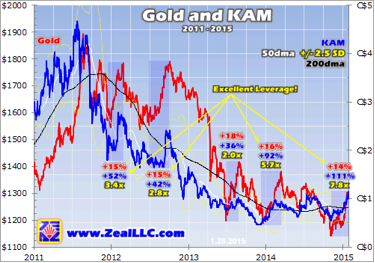
This chart shows the daily price action of gold and KAM since 2011. And as you can see, it’s been quite a rough stretch since their respective Q3 2011 all-time highs. To its 2013 low KAM was off a staggering 90% from its high. And sadly this brutal downside leverage to gold’s own 40% decline was pandemic of the entire sector.
There aren’t many positives to take out of a chart like this. But one thing that is important to observe is how a stock responds to gold when it shows signs of life. When gold moves higher, gold stocks ought to leverage to the upside. And the junior elites should offer some of this sector’s best positive leverage.
Over the course of gold’s cyclical bear market it’s been able to muster five meaningful uplegs. And as would be expected, or else it wouldn’t be worth owning, KAM positively leveraged each.
In the first two uplegs in 2012 KAM positively leveraged gold an average of 3.1x, gaining an average of nearly 50% to gold’s 15%. This is excellent leverage that will definitely keep investors coming back! But the same can’t be said for upleg #3 in 2013. KAM still outperformed gold, but only to the tune of 2.0x. This is unacceptable leverage for a junior elite, the type of action that can send investors elsewhere.
Thankfully KAM more than made up for 2013’s anomaly with stellar performance in the latest two uplegs rounding the corners of 2014 and 2015. In upleg #4 it soared an impressive 92% to gold’s 16% (5.7x leverage). And in ongoing upleg #5 it’s so far rocketed an even more impressive 111% to gold’s 14% (7.8x leverage).
So as you can see, KAM is a stock that investors will pile into when gold runs higher. Its amazing project has incredible potential even in a low-gold-price environment. And when the metal does finally run higher, this project’s value will skyrocket. Kaminak Gold is a company that both investors and major mining companies will keep a close eye on as it advances through the feasibility stage.
Kaminak is not the only junior that will thrive upon gold’s recovery though. While the pickings are slim following years of carnage, there’s an elite group that are poised to lead the next generation of gold exploration and development. And at Zeal we believe we’ve identified those with the highest probability for success.
The bottom line is the Yukon is currently experiencing its second major gold rush. But rather than pick-and-shovel death-defying treks that characterized the first go around, the modern commercial-scale miners are successfully discovering major source deposits. And none is better than the Coffee project owned by Kaminak Gold.
Coffee is host to one of the finest undeveloped gold deposits not only in the Yukon, but in all of North America. And according to the maiden economic assessment, its core resource is amenable to a highly-profitable mining operation. Kaminak is now aggressively pushing forward towards development. And if there are no surprises along the way, its stock ought to continue to positively leverage its underlying metal.
If you would like to receive our free newsletter via email, simply enter your email address below & click subscribe.
CONNECT WITH US
Tweets
Tweet with hash tag #miningfeeds or @miningfeeds and your tweets will be displayed across this site.
MOST ACTIVE MINING STOCKS
Daily Gainers
 Lincoln Minerals Limited Lincoln Minerals Limited |
LML.AX | +125.00% |
      |
GCR.AX | +33.33% |
      |
CASA.V | +30.00% |
      |
AHN.AX | +22.22% |
      |
ADD.AX | +22.22% |
      |
AZM.V | +21.98% |
      |
NSE.V | +21.05% |
      |
DYG.V | +18.42% |
      |
AAZ.V | +18.18% |
      |
GLA.AX | +17.65% |


 Follow us on Twitter
Follow us on Twitter Become our facebook fan
Become our facebook fan








